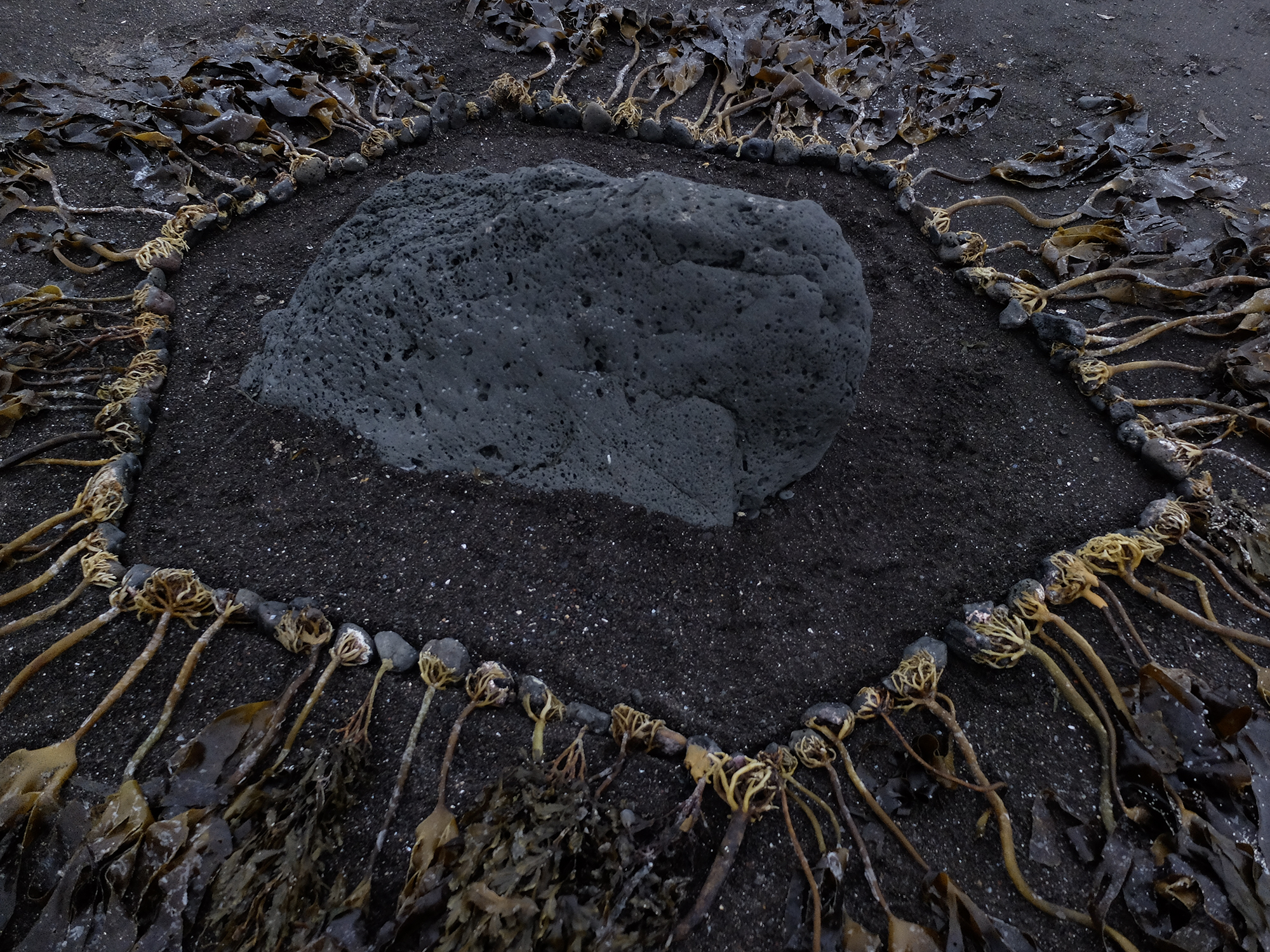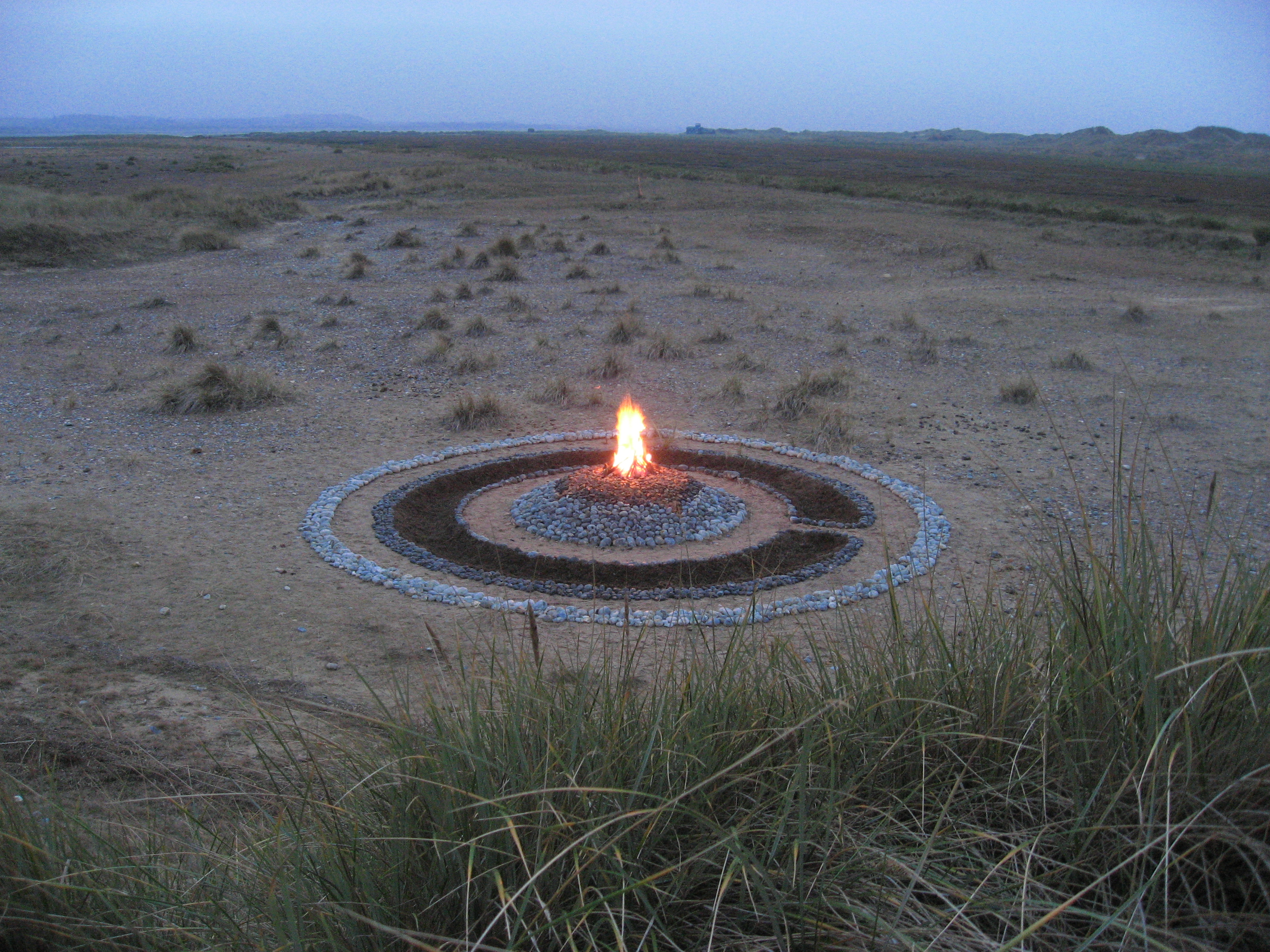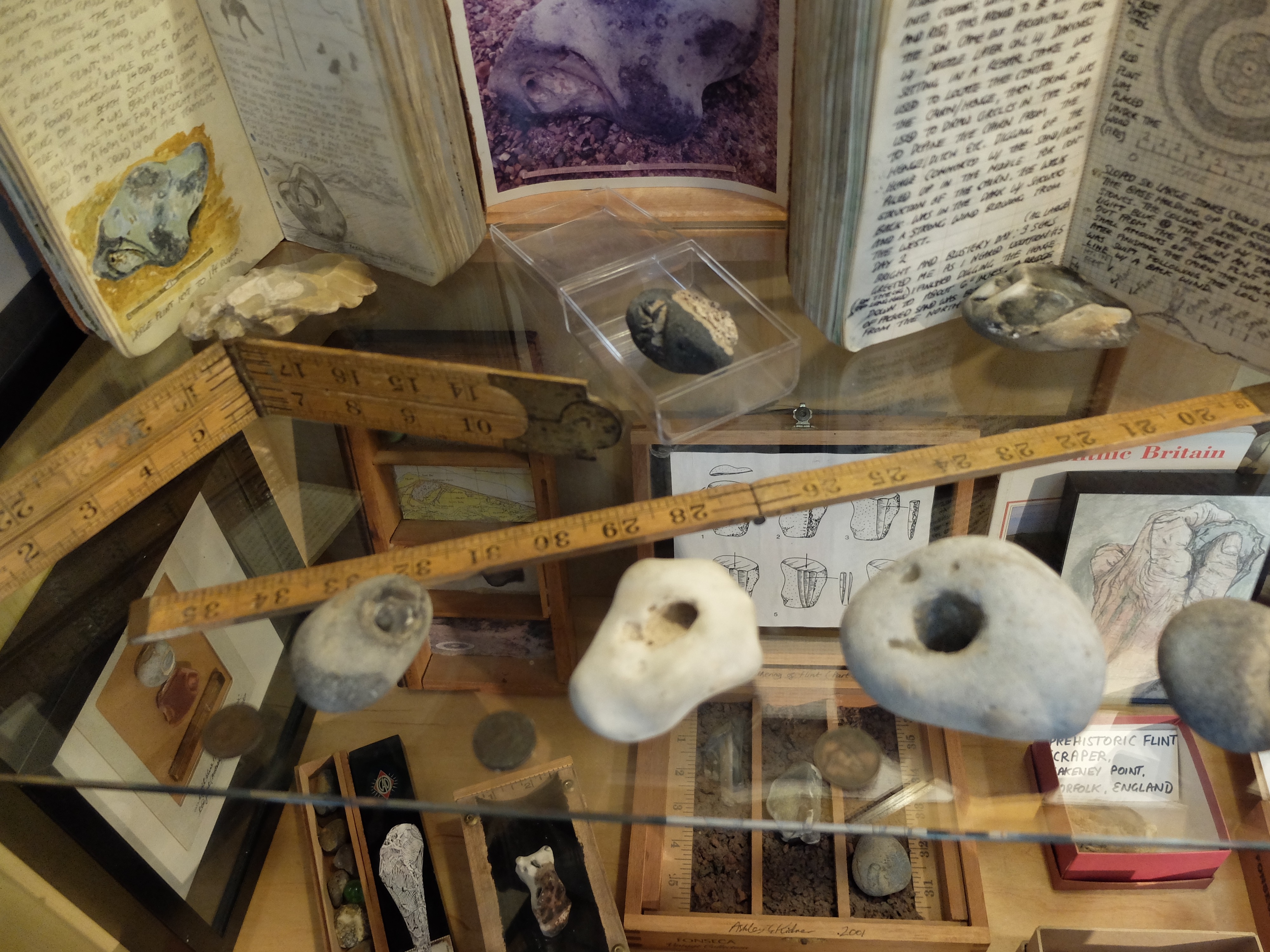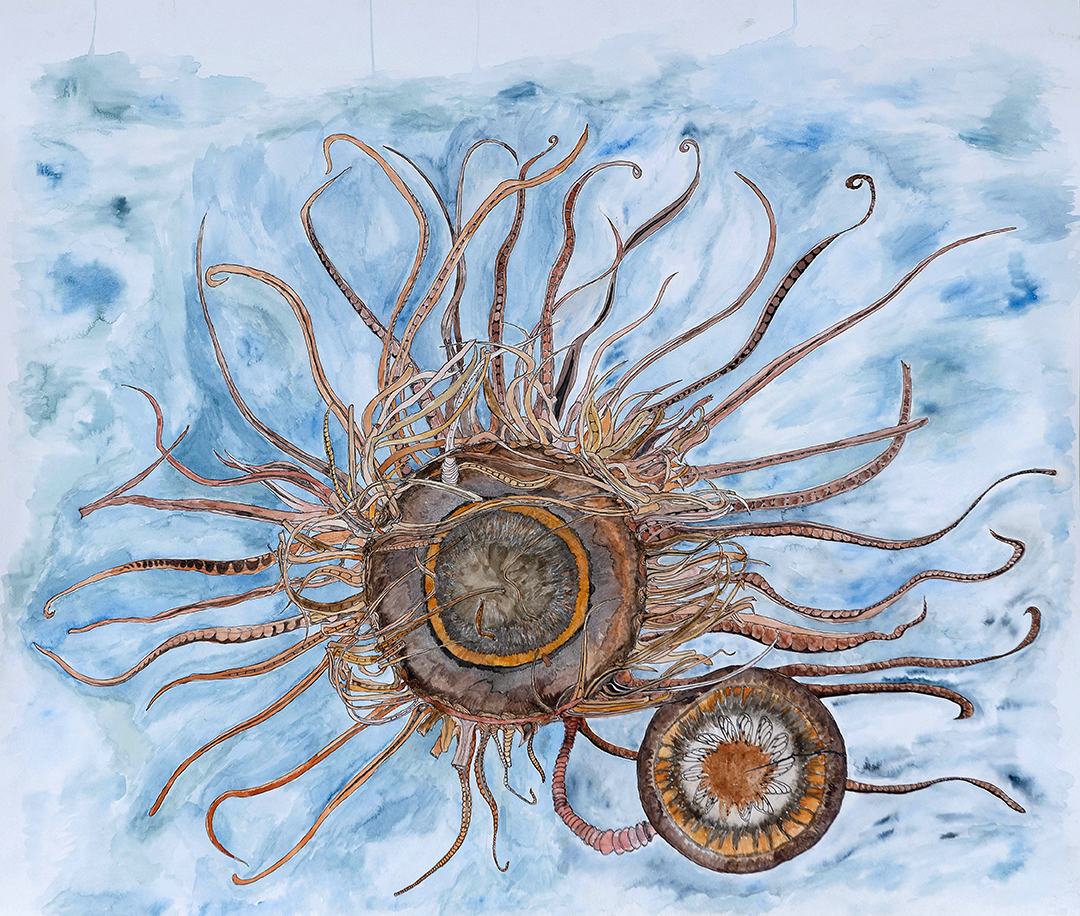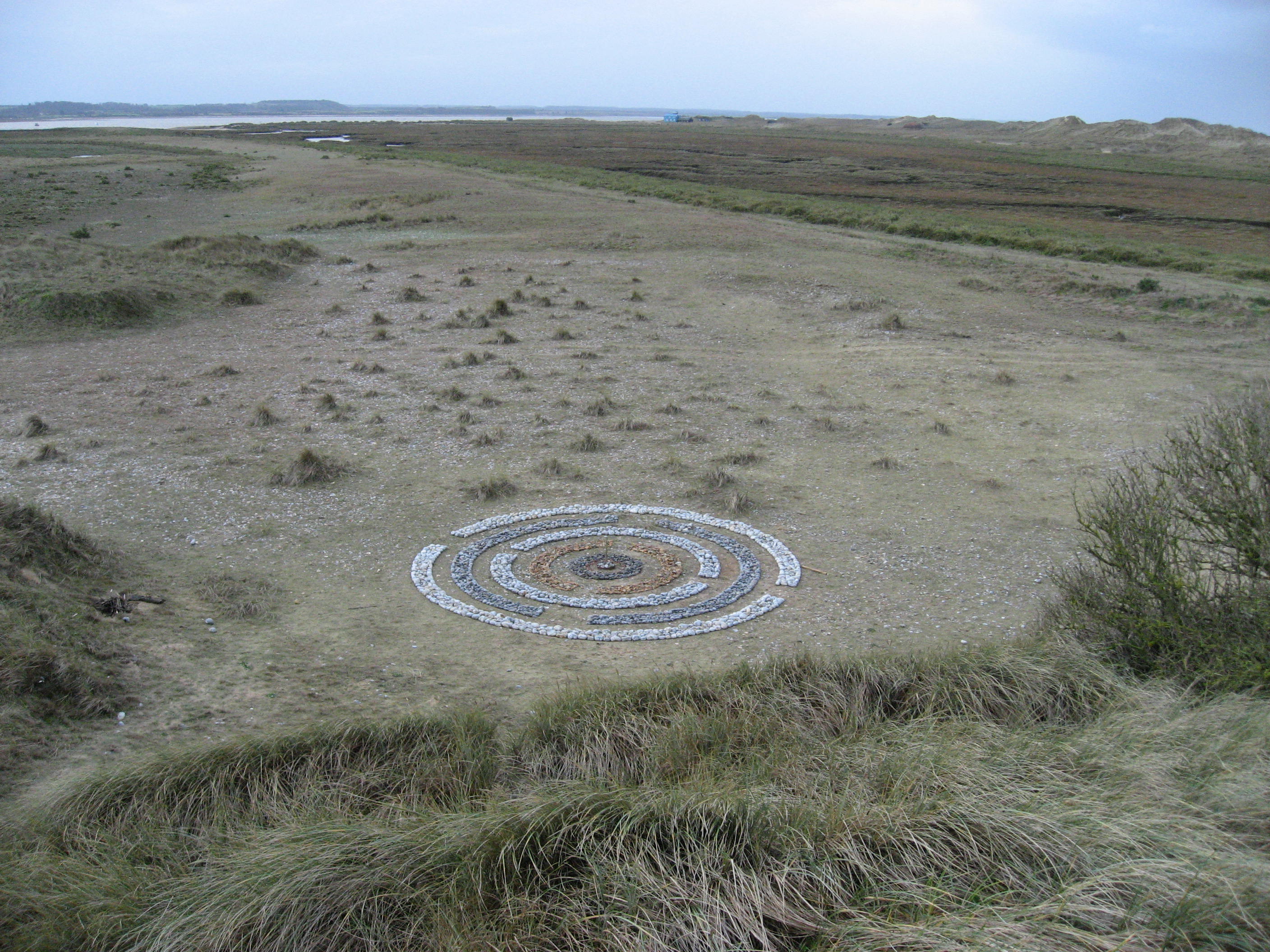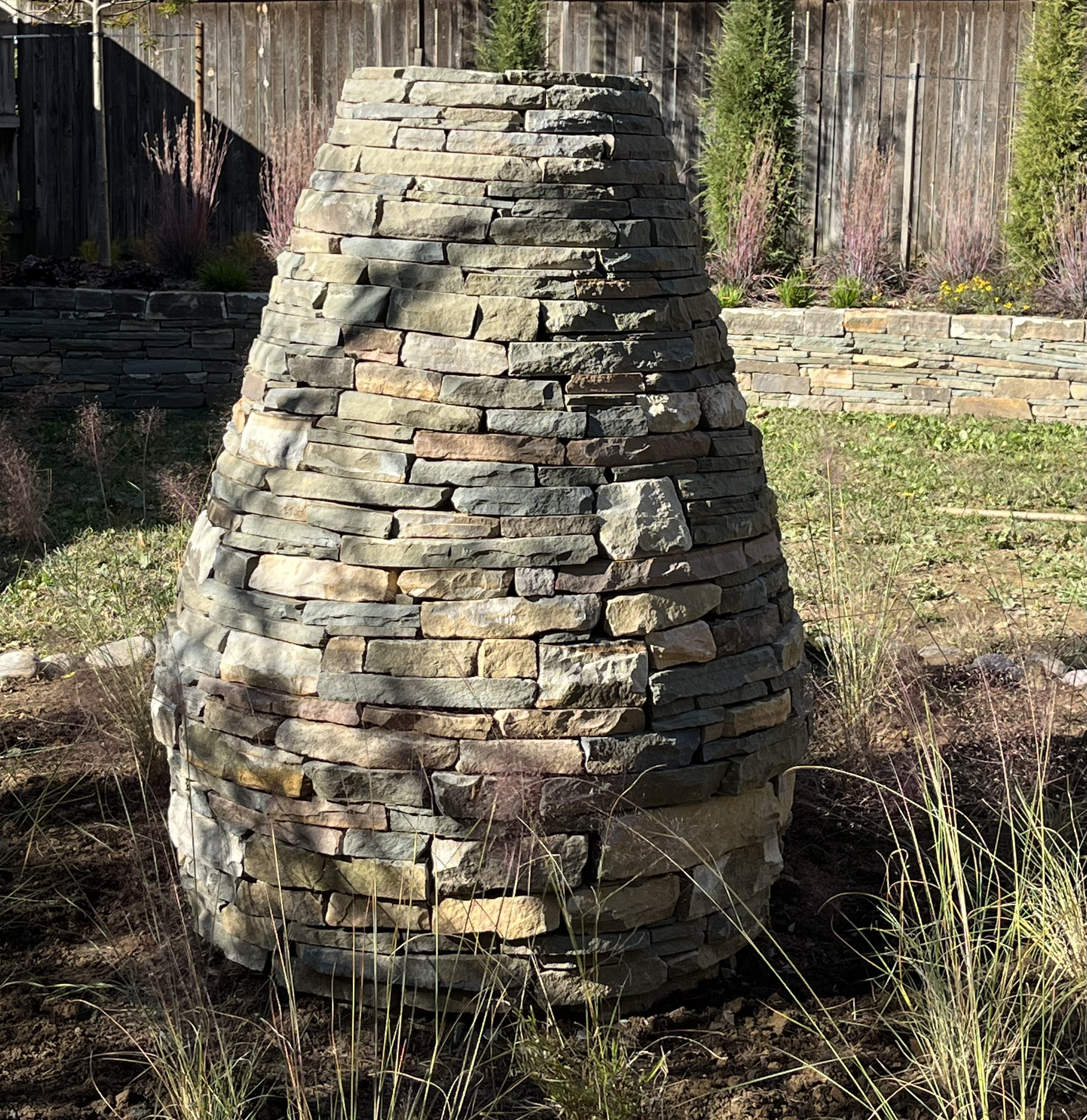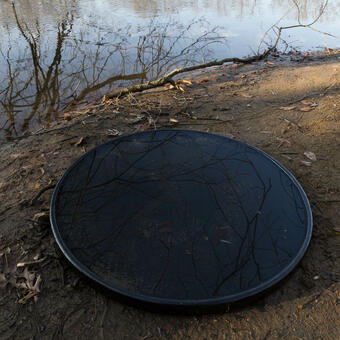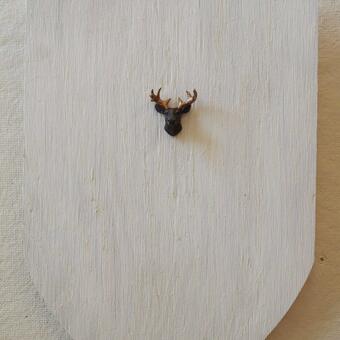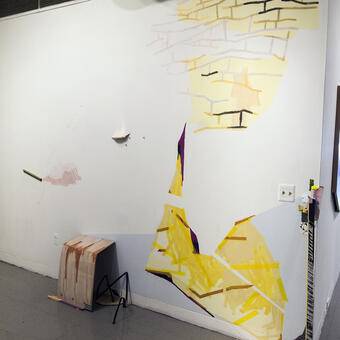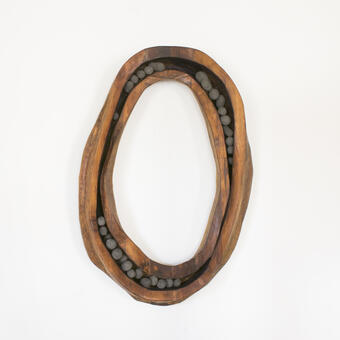About ashley
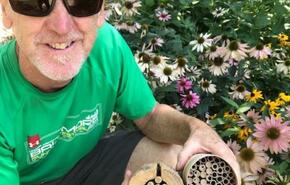
Ashley Kidner is a Baltimore based environmental artist. Kidner’s work reflects issues such as global warming, habitat loss, sea level rise and the decline of pollinators. Kidner likes to work with natural materials like stone, wood, plants and water when doing earthwork installations in different locations around the world. When in the studio Kidner works with a variety of mediums ranging from watercolors and printmaking to encaustics.
In addition to environmental artwork Kidner has… more
Swalevine 2016
-
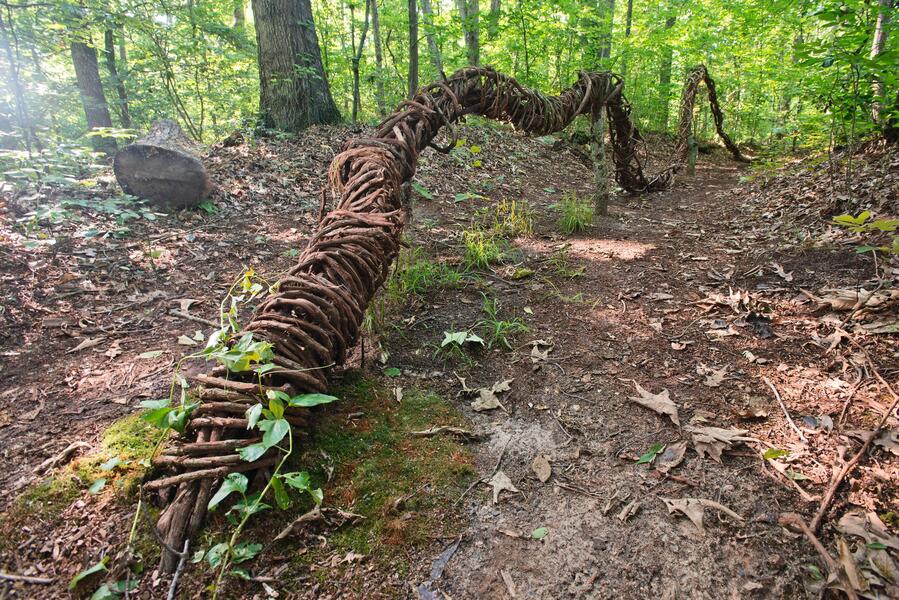 Swalevine 2016, Adkins Arboretum,MDThis installation was part of the "Artists in dialogue with nature" outdoor invitational at Adkins Arboretum, installed in late spring/early summer 2016. The installation was constructed using mainly non-native grape vines cut from the surrounding forest. The vines were twisted together to form a long (approx 85'), snaking sculpture which followed the course of a swale which may have been a road at some point in time. In the construction of the installation, dead branches were blown off and dropped into the swale, these branches were dug into the ground and used to support the heavy mass of vines. The sculpture was deemed finished when the vines became too heavy to manipulate. The native vine passionflower (passiflora incarnata), was planted at the beginning of the swalevine. The installation brings up the subject of native and non-native species and their battle for dominance in the american ecosystem.
Swalevine 2016, Adkins Arboretum,MDThis installation was part of the "Artists in dialogue with nature" outdoor invitational at Adkins Arboretum, installed in late spring/early summer 2016. The installation was constructed using mainly non-native grape vines cut from the surrounding forest. The vines were twisted together to form a long (approx 85'), snaking sculpture which followed the course of a swale which may have been a road at some point in time. In the construction of the installation, dead branches were blown off and dropped into the swale, these branches were dug into the ground and used to support the heavy mass of vines. The sculpture was deemed finished when the vines became too heavy to manipulate. The native vine passionflower (passiflora incarnata), was planted at the beginning of the swalevine. The installation brings up the subject of native and non-native species and their battle for dominance in the american ecosystem. -
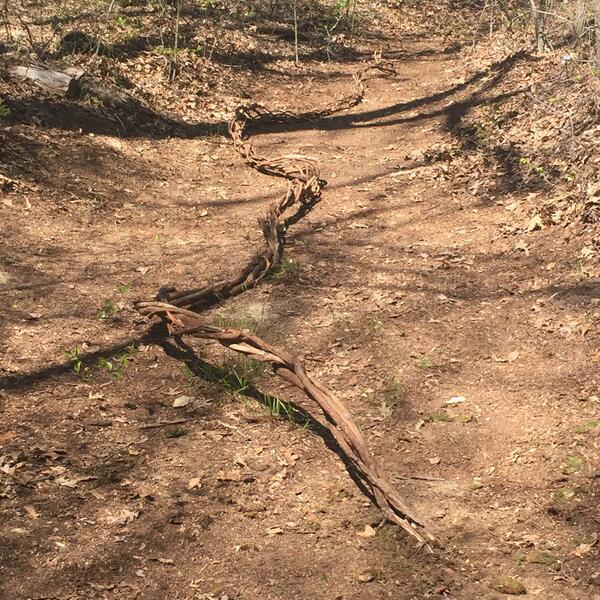 swalevine2.jpgSwalevine under construction.
swalevine2.jpgSwalevine under construction. -
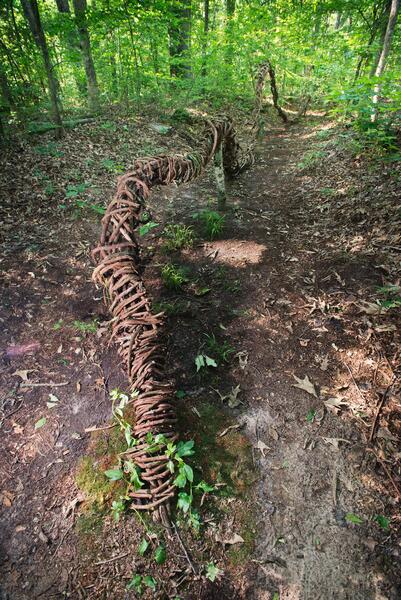 Swalevine20160625_01.jpgCompleted swalevine
Swalevine20160625_01.jpgCompleted swalevine -
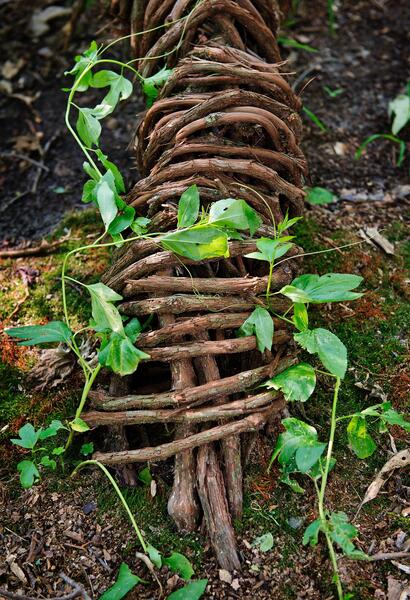 Swalevine20160625_04.jpgDetail of completed Swalevine showing native passionflower (passiflora incarnata) growing at base.
Swalevine20160625_04.jpgDetail of completed Swalevine showing native passionflower (passiflora incarnata) growing at base. -
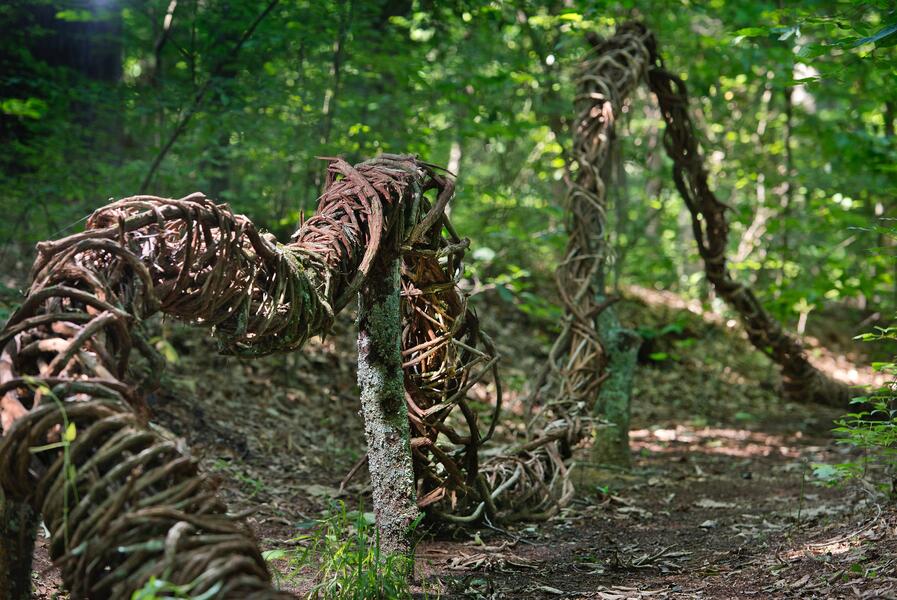 SwalevineCompleted swalevine showing supporting branches dug into ground
SwalevineCompleted swalevine showing supporting branches dug into ground -
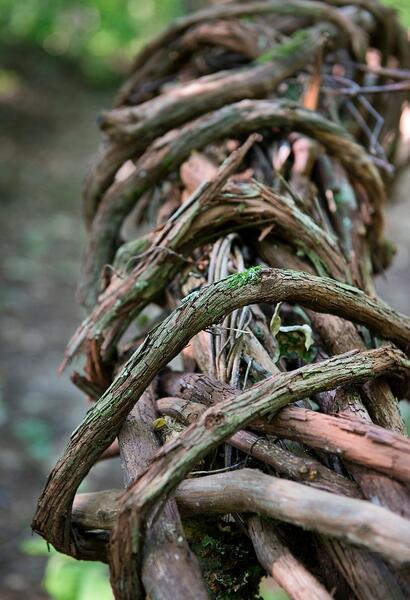 SwalevineDetail of swalevine showing showing grape vines twisted together
SwalevineDetail of swalevine showing showing grape vines twisted together
The worship of Basalt part 1 & 2, Reykjavik, Iceland, 2014
-
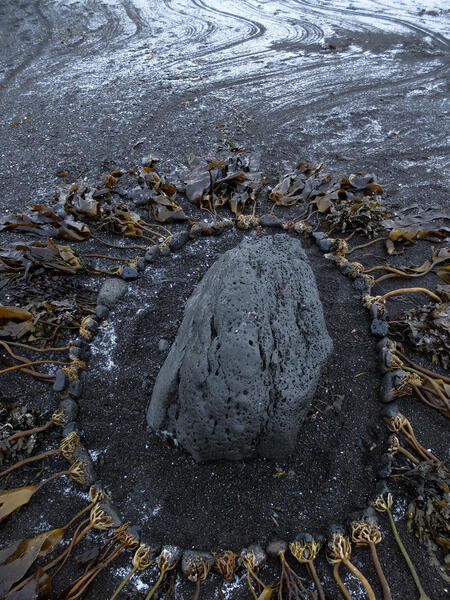 The worship of Basalt part 2Basalt stones with kelp attached face a large boulder of basalt.
The worship of Basalt part 2Basalt stones with kelp attached face a large boulder of basalt. -
 The worship of BasaltSmall basalt stones with kelp attached. The roots from the kelp were able to penetrate the porous basalt stones.
The worship of BasaltSmall basalt stones with kelp attached. The roots from the kelp were able to penetrate the porous basalt stones. -
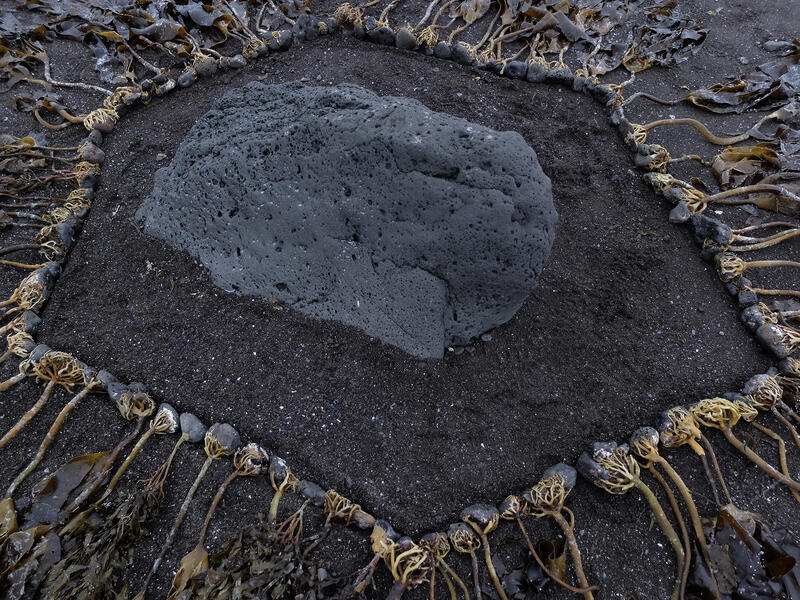 The worship of Basalt part 1The basalt boulder lies amongst the tiny grains of basalt sand eroded from previous boulders.
The worship of Basalt part 1The basalt boulder lies amongst the tiny grains of basalt sand eroded from previous boulders. -
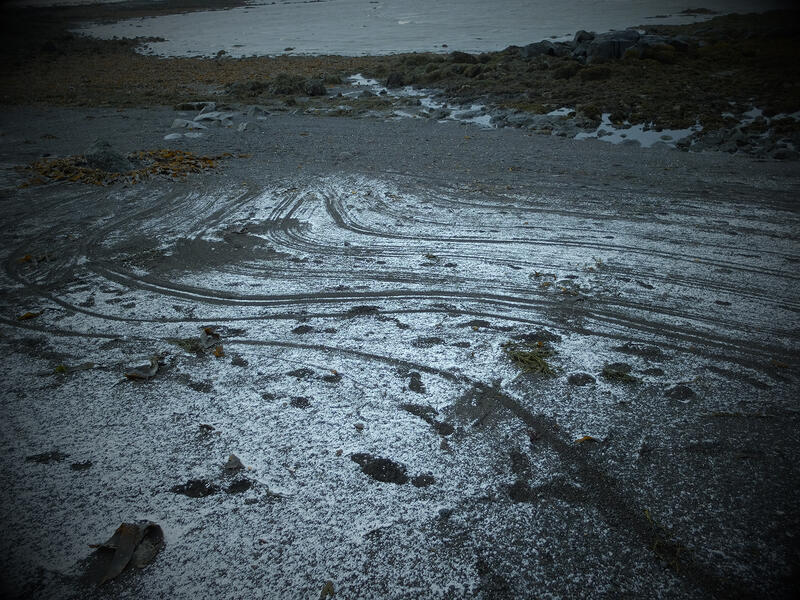 The worship of BasaltLines left in the snow covered sand from dragging the basalt stones with kelp attached.
The worship of BasaltLines left in the snow covered sand from dragging the basalt stones with kelp attached. -
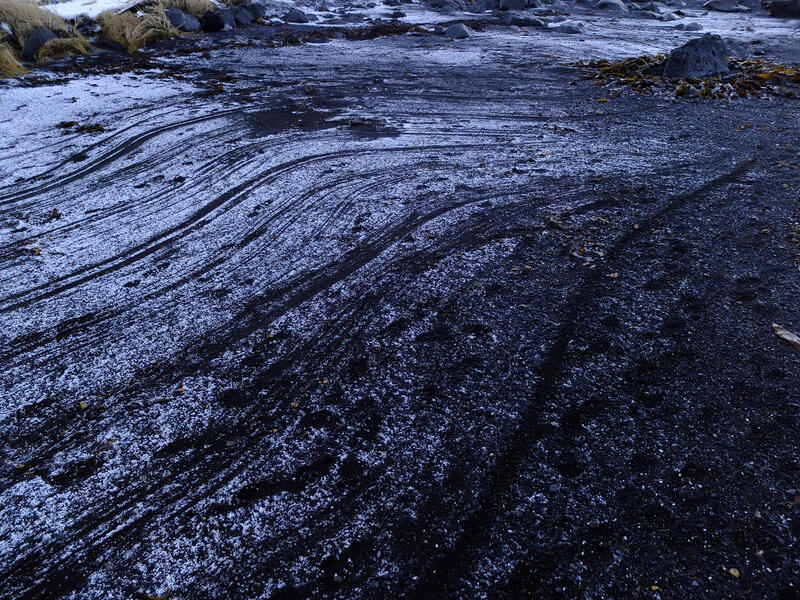 The worship of BasaltLines in the sand and snow as the pebbles make their way towards the basalt boulder dragging the kelp behind them.
The worship of BasaltLines in the sand and snow as the pebbles make their way towards the basalt boulder dragging the kelp behind them. -
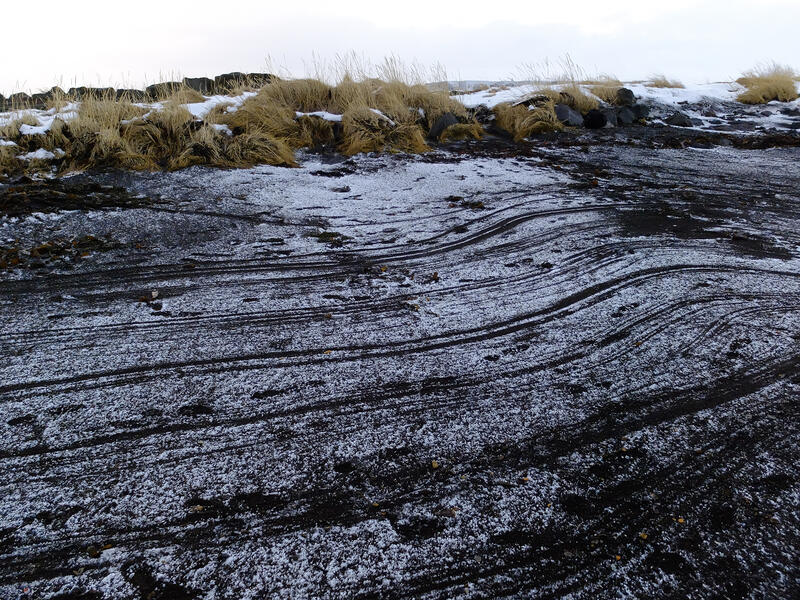 The worship of BasaltLines in the snow and sand from the small pebbles dragged across the beach towards the basalt boulder.
The worship of BasaltLines in the snow and sand from the small pebbles dragged across the beach towards the basalt boulder. -
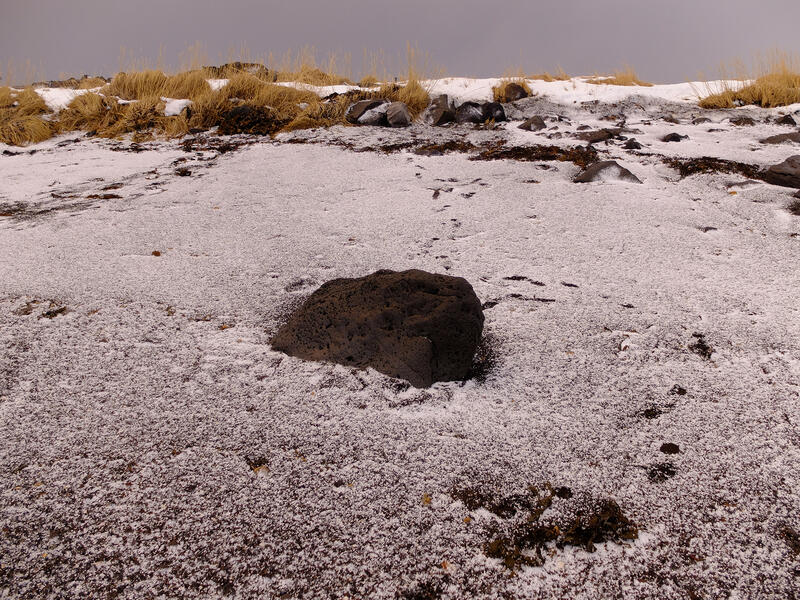 The worship of BasaltThe basalt boulder lies alone on the beach in Reykjavik.
The worship of BasaltThe basalt boulder lies alone on the beach in Reykjavik. -
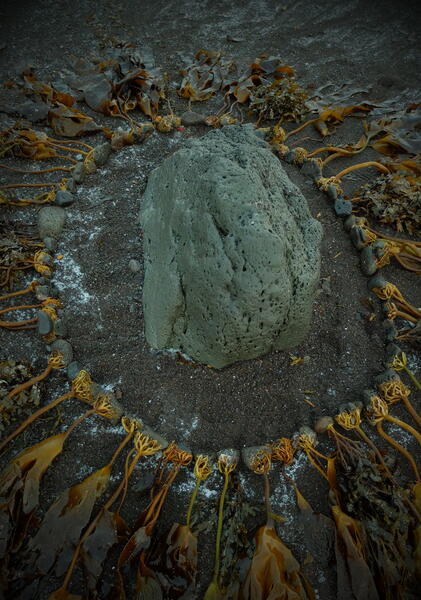 The worship of Basalt part 2The small basalt pebbles encircle and pay homage to the boulder
The worship of Basalt part 2The small basalt pebbles encircle and pay homage to the boulder -
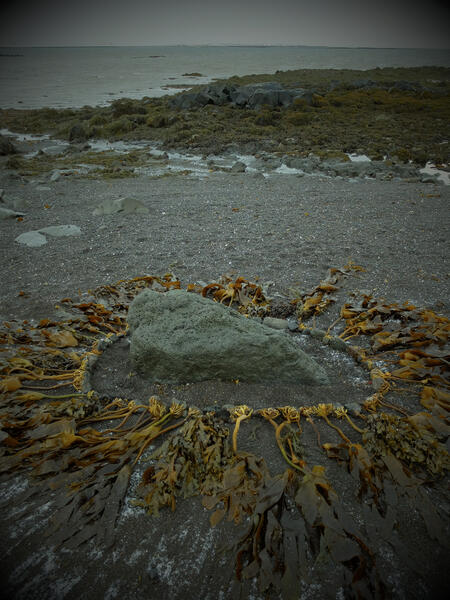 The worship of Basalt part 2Kelp attached to small basalt stones dragged across the black basalt sand to face the basalt boulder.
The worship of Basalt part 2Kelp attached to small basalt stones dragged across the black basalt sand to face the basalt boulder. -
 The worship of Basalt part 1The basalt stones with kelp trailing behind form a hexagon around the basalt boulder.
The worship of Basalt part 1The basalt stones with kelp trailing behind form a hexagon around the basalt boulder.
Nature Art in the Park (Leakin Park), Art on the Trail (Lake Roland Park) and other installations installed in US
These works are part of the Art on the Trail series of installations at Lake Roland Park, Baltimore and Nature Art in the Park work in Leakin Park, Baltimore (2014 to Present). They include my Pollinator Hexagon series of installations. In addition to other work installed in the US.
https://chesapeakebaymagazine.com/art-on-the-waterfront-brings-inspired-outdoor-art-to-south-baltimore/
-
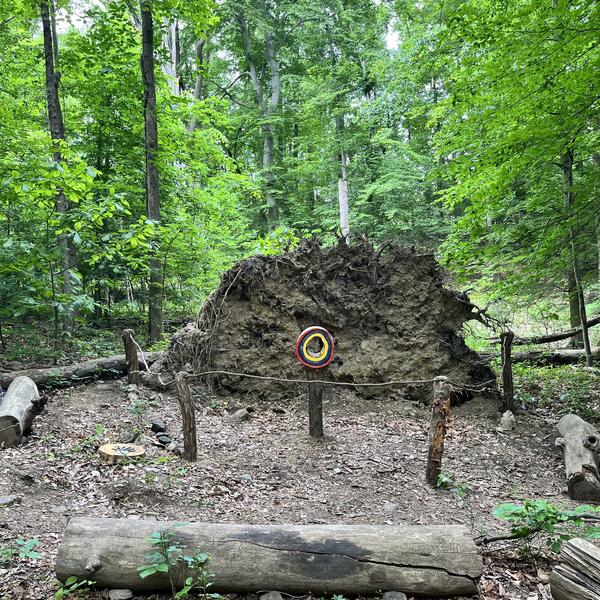 Monument to a Fallen Oak
Monument to a Fallen OakMonument to a Fallen Oak, 2023, mixed media installation, (130ft by 35ft by 8ft) for Nature Art in the Park 2023
-
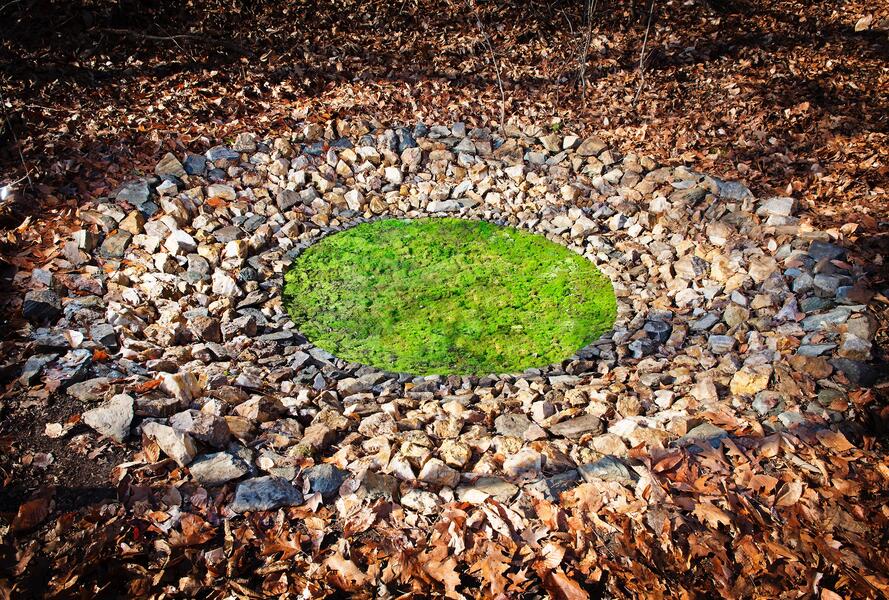 Earth Transfer(second phase) Anti-cline (2015)Earth transfer installed at Lake Roland moss and stone 12ft diameter
Earth Transfer(second phase) Anti-cline (2015)Earth transfer installed at Lake Roland moss and stone 12ft diameter -
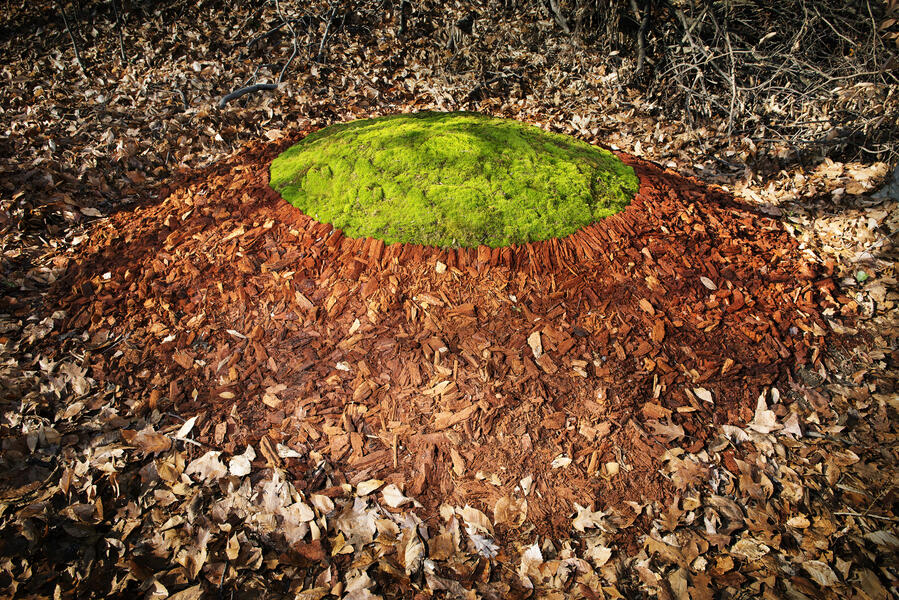 Earth transfer with stone, wood and mossInstalled at Lake Roland for Art on the Trail exhibit Northern mound or barrow; Fall phase; 12ft diameter moss circle surrounded by rotting cedar mulch found nearby. Photo by greg Dohler
Earth transfer with stone, wood and mossInstalled at Lake Roland for Art on the Trail exhibit Northern mound or barrow; Fall phase; 12ft diameter moss circle surrounded by rotting cedar mulch found nearby. Photo by greg Dohler -
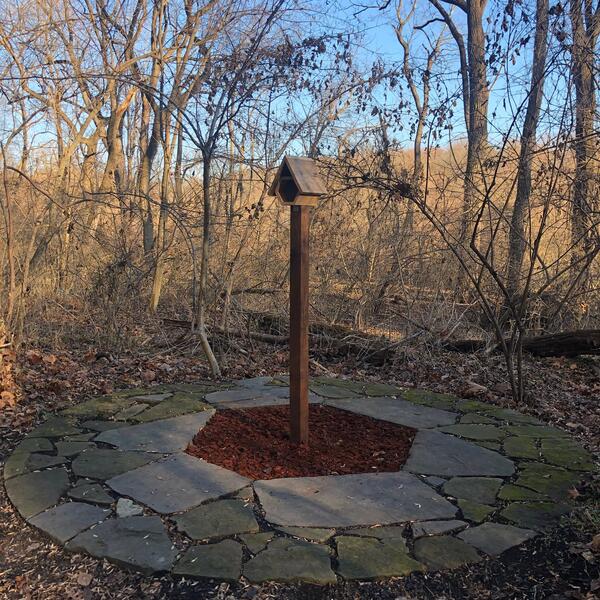 Pollinator hexagon I with solitary bee house (2019)My pollinator hexagon I installation has the addition of a solitary bee house above replanted pycanthemum viginianum (mountain mint).
Pollinator hexagon I with solitary bee house (2019)My pollinator hexagon I installation has the addition of a solitary bee house above replanted pycanthemum viginianum (mountain mint). -
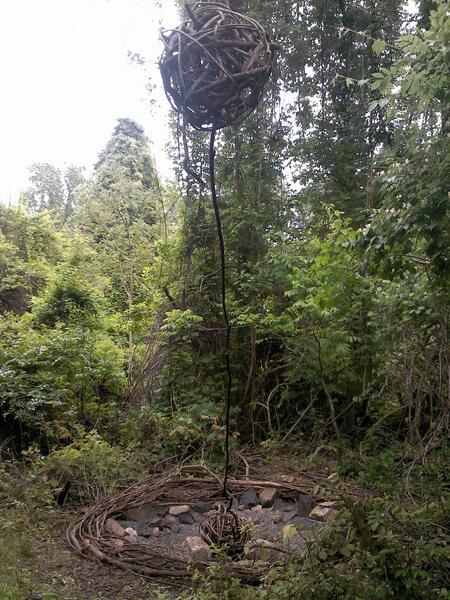 Well of Passion, 2014Well of Passion, Nature Art in the Park 2014. Vine balls constructed from wisteria vines, gravel and boulders.
Well of Passion, 2014Well of Passion, Nature Art in the Park 2014. Vine balls constructed from wisteria vines, gravel and boulders. -
 Swalevine 2016, Adkins Arboretum,MDThis installation was part of the "Artists in dialogue with nature" outdoor invitational at Adkins Arboretum, installed in late spring/early summer 2016. The installation was constructed using mainly non-native grape vines cut from the surrounding forest. The vines were twisted together to form a long (approx 85'), snaking sculpture which followed the course of a swale which may have been a road at some point in time. In the construction of the installation, dead branches were blown off and dropped into the swale, these branches were dug into the ground and used to support the heavy mass of vines. The sculpture was deemed finished when the vines became too heavy to manipulate. The native vine passionflower (passiflora incarnata), was planted at the beginning of the swalevine. The installation brings up the subject of native and non-native species and their battle for dominance in the american ecosystem.
Swalevine 2016, Adkins Arboretum,MDThis installation was part of the "Artists in dialogue with nature" outdoor invitational at Adkins Arboretum, installed in late spring/early summer 2016. The installation was constructed using mainly non-native grape vines cut from the surrounding forest. The vines were twisted together to form a long (approx 85'), snaking sculpture which followed the course of a swale which may have been a road at some point in time. In the construction of the installation, dead branches were blown off and dropped into the swale, these branches were dug into the ground and used to support the heavy mass of vines. The sculpture was deemed finished when the vines became too heavy to manipulate. The native vine passionflower (passiflora incarnata), was planted at the beginning of the swalevine. The installation brings up the subject of native and non-native species and their battle for dominance in the american ecosystem. -
Pollinator Hexagon IVPollinator Hexagon IV (2018); Installed for the Art on the Waterfront show in Middle branch Park. The stone was delaware river gravel. Central zone; Rudbeckia maxima (giant coneflower) Middle zones; Echinacea purpurea "magnus" (purple coneflower) Outer zones Asclepias tuberosa (butterfly weed)
-
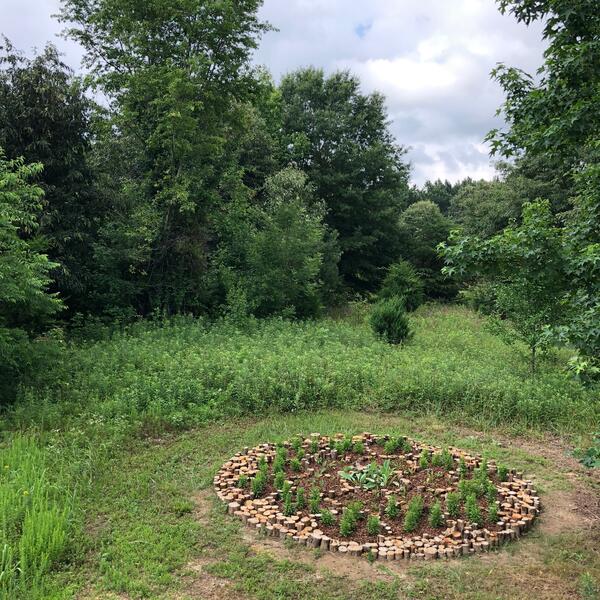 Pollinator Hexagon VPollinator Hexagon V (2018); Installed for the Artists in Dialogue with Nature show at Adkins Arboretum, Ridgely MD. The dead wood was collected from around the Arboretum and was a mixture of loblolly pine, red maple and other native trees. Central zone; Rudbeckia maxima (giant cone flower), Middle zones Echinacea purpurea "rubinstern" (purple coneflower) outer zones; Solidago hybrida "little lemon" (Little lomon goldenrod)
Pollinator Hexagon VPollinator Hexagon V (2018); Installed for the Artists in Dialogue with Nature show at Adkins Arboretum, Ridgely MD. The dead wood was collected from around the Arboretum and was a mixture of loblolly pine, red maple and other native trees. Central zone; Rudbeckia maxima (giant cone flower), Middle zones Echinacea purpurea "rubinstern" (purple coneflower) outer zones; Solidago hybrida "little lemon" (Little lomon goldenrod) -
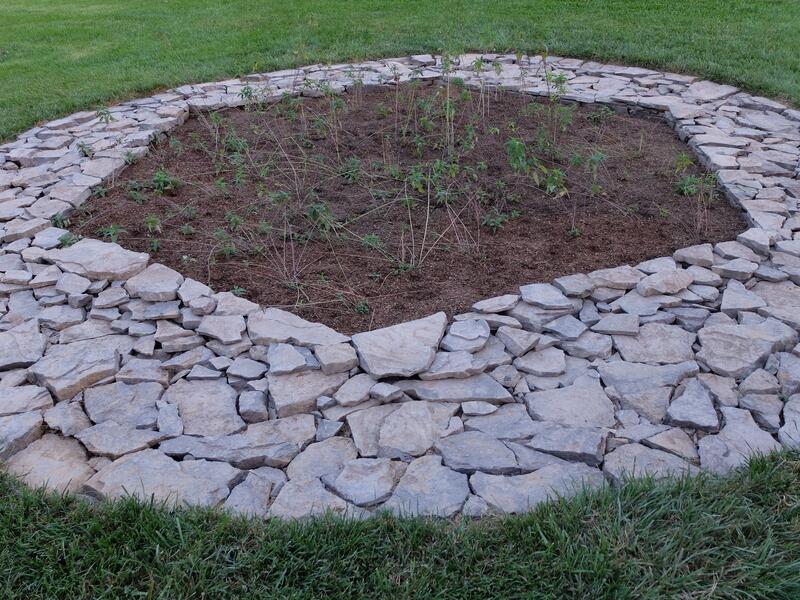 Pollinator Hexagon IIThis installation was part of the 2017 Inside/Out sculpture show at Montpellier Arts center in Laurel, MD. The stone used was colonial wallstone and the perennials were Monarda fistulosa (wild bergamont)
Pollinator Hexagon IIThis installation was part of the 2017 Inside/Out sculpture show at Montpellier Arts center in Laurel, MD. The stone used was colonial wallstone and the perennials were Monarda fistulosa (wild bergamont) -
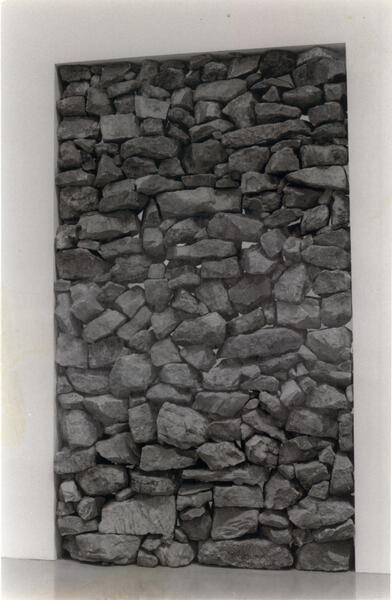 Jannis Kounellis stone wall 2002This wall was installed as part of the 2002 Arte Povera show in the Hirshhorn museum in DC. We followed the instructions of the artist to create a free standing dry laid wall that was visible from both sides using local stone, in this case western MD fieldstone.
Jannis Kounellis stone wall 2002This wall was installed as part of the 2002 Arte Povera show in the Hirshhorn museum in DC. We followed the instructions of the artist to create a free standing dry laid wall that was visible from both sides using local stone, in this case western MD fieldstone.
Blakeney Point Flint Project #5 (cairn with fire and henge) Norfolk, England, 2007. Including the Blakeney Point Flint Project cabinet for the Artscape 2017 Fieldwork exhibition.
Installed on Blakeney Point, Norfolk, England, December 28th-31st 2007.
Exhibited as part of Artscape 2017 fieldwork group show.
Circle diameter 20ft, height of cairn 3ft
Blakeney Point Flint Project #5 was the culmination of 4 previous installations (or sketches) in exactly the same location on the western side of a large sand dune just above normal high tide. Flint was collected from the surrounding area and sorted into 6 colors; white, blue, light blue, black, tan, red. The position of the cairn and henge were marked, sand was excavated from the henge to form the mound for the cairn. The different colored flints were then placed to form the outer circle (white), henge (blue) and cairn (light blue, black, tan and red). Washed up vegetation (jetsam and flotsam) were placed in the henge.
Dry driftwood was collected and used to build a fire on the top of the cairn. The installation was a homage to the Neolithic stone circles found throughout the British Iles.
-
 Blakeney Point Flint Project #5 2007Photograph taken from the dunes just above the installation.Cairn, henge and stonework completed, fire lit and burning in the late afternoon.
Blakeney Point Flint Project #5 2007Photograph taken from the dunes just above the installation.Cairn, henge and stonework completed, fire lit and burning in the late afternoon. -
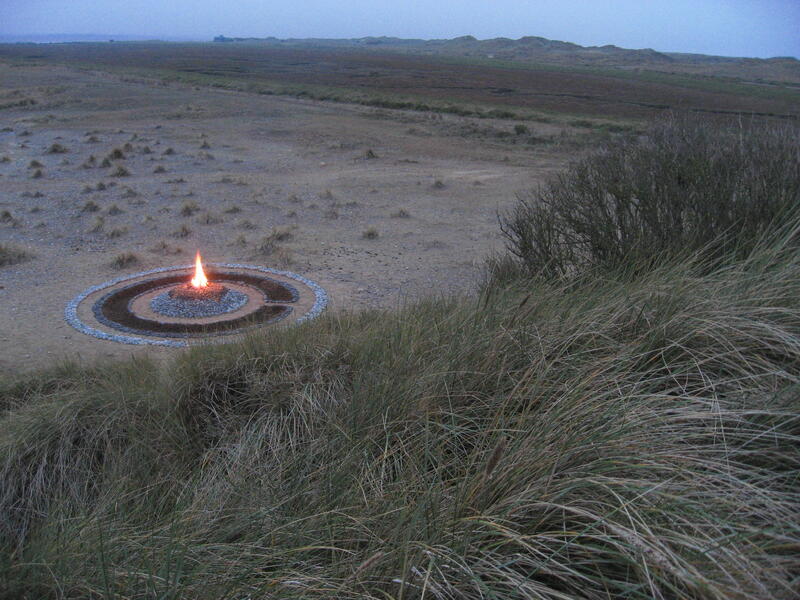 Blakeney Point flint project #5Photo taken from the sand dunes to the east
Blakeney Point flint project #5Photo taken from the sand dunes to the east -
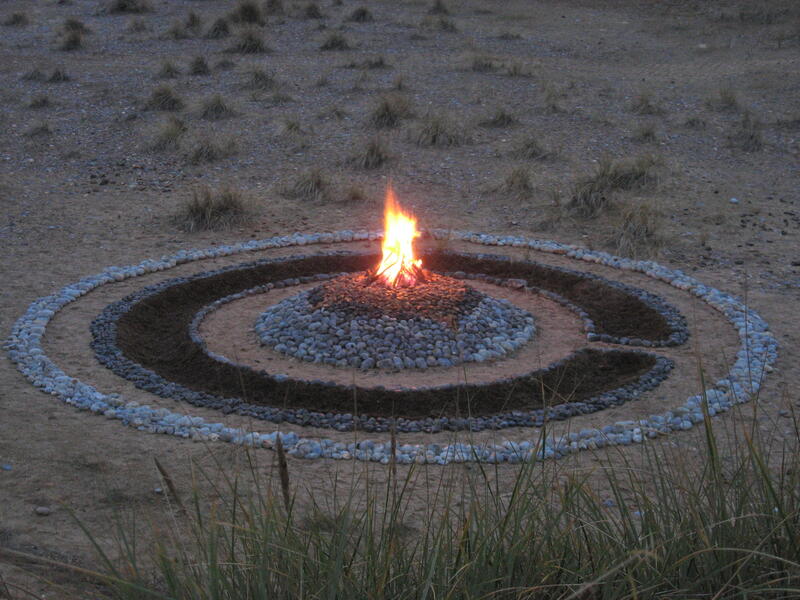 Blakeney Point flint project #5 2007Detail of mound or barrow with fire burning, the entrance (to the right of the picture) marks north.
Blakeney Point flint project #5 2007Detail of mound or barrow with fire burning, the entrance (to the right of the picture) marks north. -
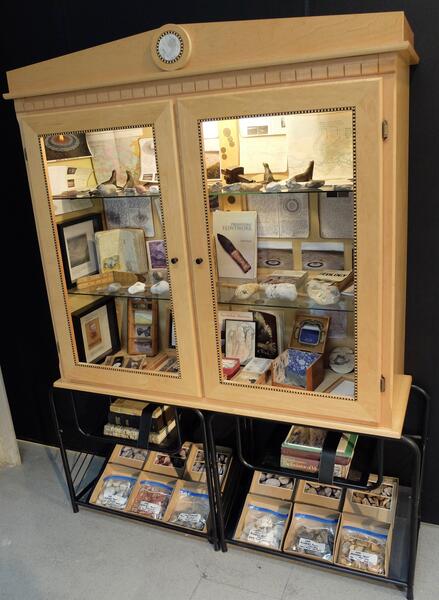 Blakeney Point Flint project cabinet installed for Artscape 2017 Fieldwork Exhibtion.
Blakeney Point Flint project cabinet installed for Artscape 2017 Fieldwork Exhibtion.This cabinet installation was exhibited as part of the Fieldwork exhibition for Artscape 2017. It contained photographs, sketches, samples of flint, box constructions and reference books all related to the Blakeney Point flint projects installed in Norfolk, England between 2003-2008.
-
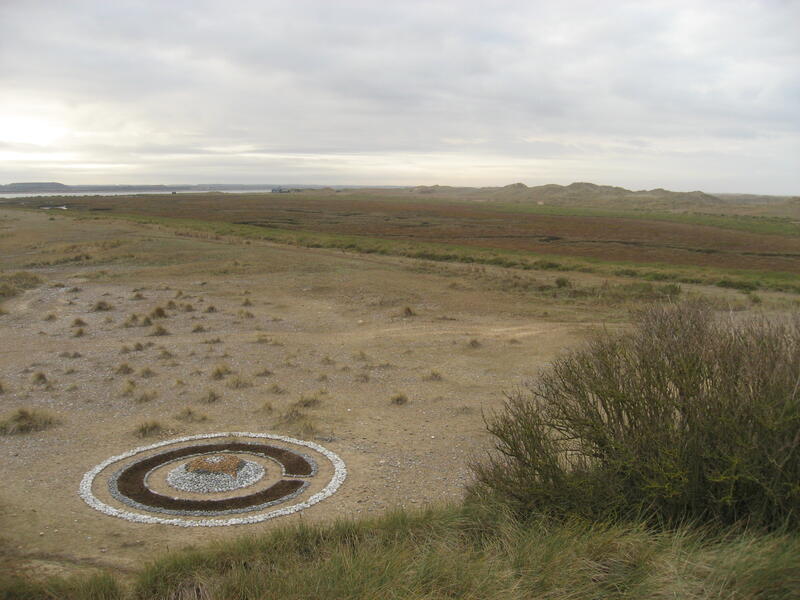 Blakeney Point flint project #53rd day after construction of Circle, henge and barrow.
Blakeney Point flint project #53rd day after construction of Circle, henge and barrow. -
Blakeney point flint project #5 2007
This photograph shows a close up of the installation after the central fire had burned.
-
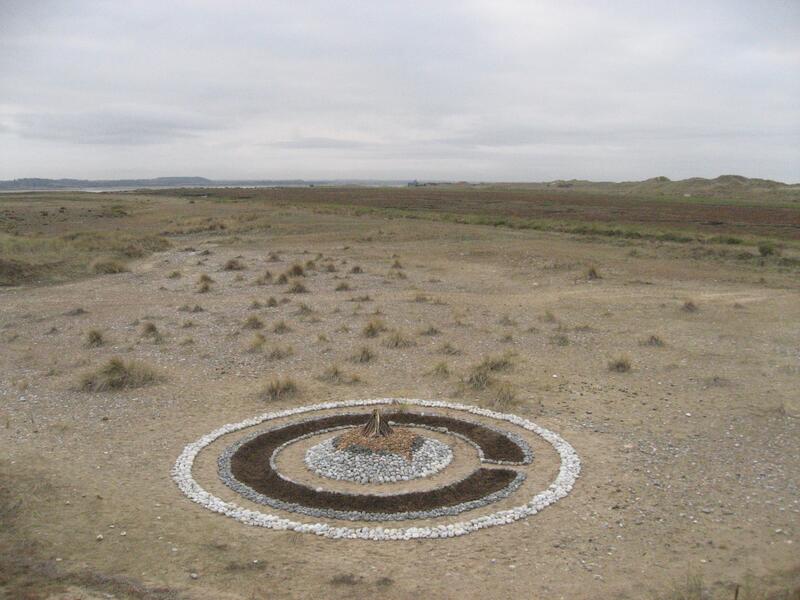 Blakeney Point flint project #5 2007Photo just before fire was lit
Blakeney Point flint project #5 2007Photo just before fire was lit -
 Bakeney Point Flint Project cabinet (detail), Part of the Artscape 2017 Fieldwork Exhibition
Bakeney Point Flint Project cabinet (detail), Part of the Artscape 2017 Fieldwork Exhibition -
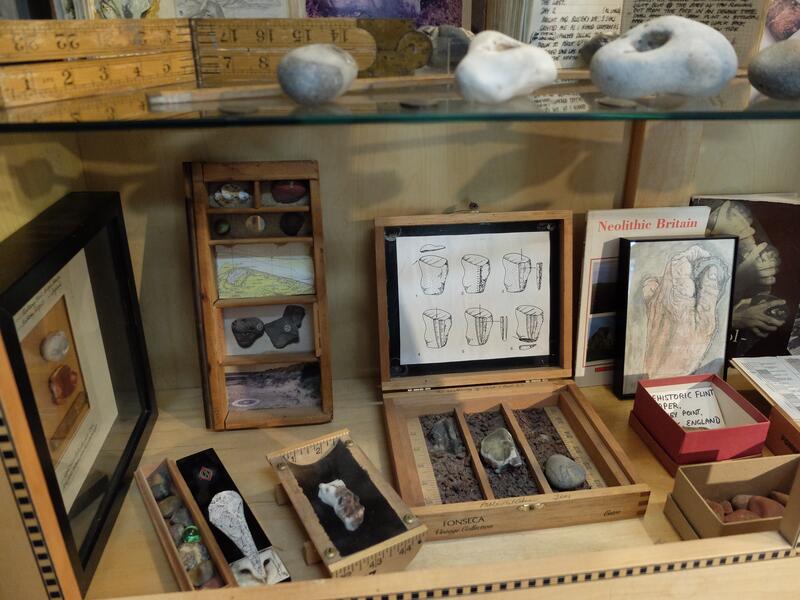 Blakeney Point Flint Project cabinet; detail.Detail of the Blakeney Point flint project cabinet installed for Artscape 2017 Fieldwork exhibition showing box constructions and flint samples
Blakeney Point Flint Project cabinet; detail.Detail of the Blakeney Point flint project cabinet installed for Artscape 2017 Fieldwork exhibition showing box constructions and flint samples -
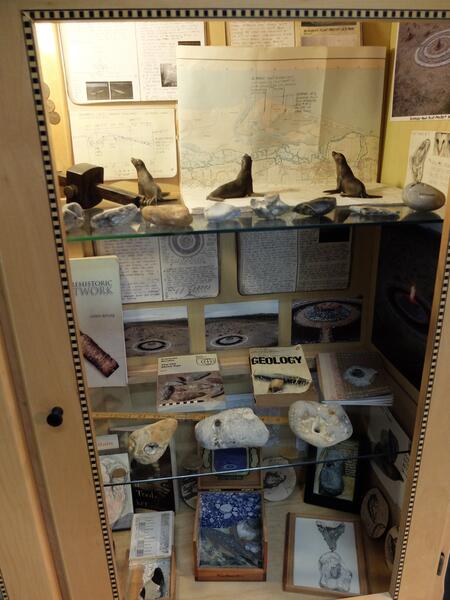 Blakeney Point Flint project cabinet (2017)Detail of the right side of the Blakeney Point flint project cabinet show at the Artscape 2017 Fieldwork exhibition in MICA's Bunting building.
Blakeney Point Flint project cabinet (2017)Detail of the right side of the Blakeney Point flint project cabinet show at the Artscape 2017 Fieldwork exhibition in MICA's Bunting building.
American Installations
Here's a link to the Chesapeake Bay Magazine review of Art on the Waterfront (2018) featuring my Pollinator Hexagon V installation
https://chesapeakebaymagazine.com/art-on-the-waterfront-brings-inspired-outdoor-art-to-south-baltimore/
-
Pollinator Hexagon IVPollinator Hexagon IV (2018); Installed for the Art on the Waterfront show in Middle branch Park. The stone was delaware river gravel. Central zone; Rudbeckia maxima (giant coneflower) Middle zones; Echinacea purpurea "magnus" (purple coneflower) Outer zones Asclepias tuberosa (butterfly weed)
-
 Jannis Kounellis stone wall 2002This wall was installed as part of the 2002 Arte Povera show in the Hirshhorn museum in DC. We followed the instructions of the artist to create a free standing dry laid wall that was visible from both sides using local stone, in this case western MD fieldstone.
Jannis Kounellis stone wall 2002This wall was installed as part of the 2002 Arte Povera show in the Hirshhorn museum in DC. We followed the instructions of the artist to create a free standing dry laid wall that was visible from both sides using local stone, in this case western MD fieldstone. -
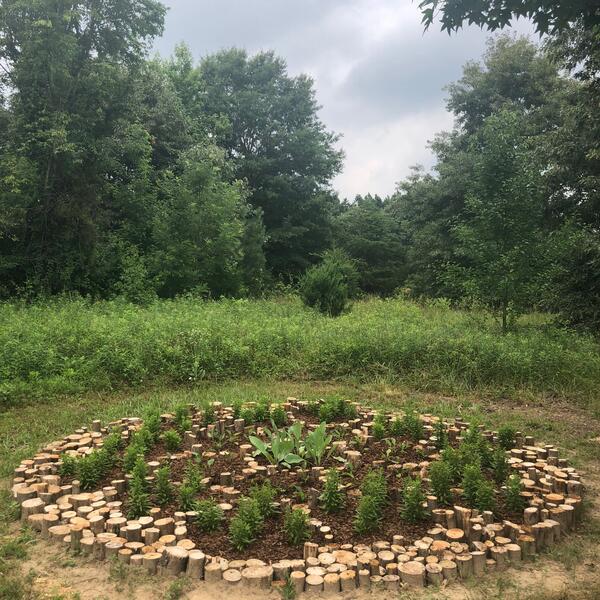 Pollinator Hexagon VInstalled at Adkins Arboretum on the Eastern shore of MD in 2018 for the Artists in dialogue with Nature sculpture exhibitio. The installation features found wood usded to construct the hexagon and native plants to attract pollinators.
Pollinator Hexagon VInstalled at Adkins Arboretum on the Eastern shore of MD in 2018 for the Artists in dialogue with Nature sculpture exhibitio. The installation features found wood usded to construct the hexagon and native plants to attract pollinators. -
 Swalevine 2016, Adkins Arboretum,MDThis installation was part of the "Artists in dialogue with nature" outdoor invitational at Adkins Arboretum, installed in late spring/early summer 2016. The installation was constructed using mainly non-native grape vines cut from the surrounding forest. The vines were twisted together to form a long (approx 85'), snaking sculpture which followed the course of a swale which may have been a road at some point in time. In the construction of the installation, dead branches were blown off and dropped into the swale, these branches were dug into the ground and used to support the heavy mass of vines. The sculpture was deemed finished when the vines became too heavy to manipulate. The native vine passionflower (passiflora incarnata), was planted at the beginning of the swalevine. The installation brings up the subject of native and non-native species and their battle for dominance in the american ecosystem.
Swalevine 2016, Adkins Arboretum,MDThis installation was part of the "Artists in dialogue with nature" outdoor invitational at Adkins Arboretum, installed in late spring/early summer 2016. The installation was constructed using mainly non-native grape vines cut from the surrounding forest. The vines were twisted together to form a long (approx 85'), snaking sculpture which followed the course of a swale which may have been a road at some point in time. In the construction of the installation, dead branches were blown off and dropped into the swale, these branches were dug into the ground and used to support the heavy mass of vines. The sculpture was deemed finished when the vines became too heavy to manipulate. The native vine passionflower (passiflora incarnata), was planted at the beginning of the swalevine. The installation brings up the subject of native and non-native species and their battle for dominance in the american ecosystem. -
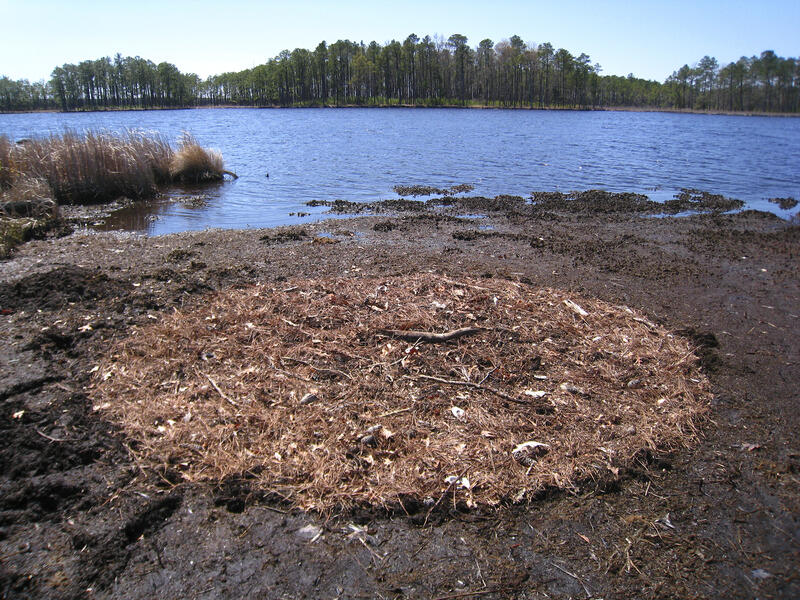 Blackwater project 2009North side of river This photo shows the leaves transported from the south side of the river and placed in a 10ft diameter circle on the north side of the Blackwater river. This piece talks about the runoff of fertilizer from farmland close to the river and the continuing pollution of the Chesapeake Bay.
Blackwater project 2009North side of river This photo shows the leaves transported from the south side of the river and placed in a 10ft diameter circle on the north side of the Blackwater river. This piece talks about the runoff of fertilizer from farmland close to the river and the continuing pollution of the Chesapeake Bay. -
 Blackwater project 2009Southern side of river; Blackwater River on the Eastern shore of Maryland. This project involved transferring 2 circles of surface debris (10ft in diameter) from one side of the Blackwater river to the other. This was done using a kayak towing a small barge. This photo shows the fine mud transported from the north side of the river and placed in a circle on the south side.
Blackwater project 2009Southern side of river; Blackwater River on the Eastern shore of Maryland. This project involved transferring 2 circles of surface debris (10ft in diameter) from one side of the Blackwater river to the other. This was done using a kayak towing a small barge. This photo shows the fine mud transported from the north side of the river and placed in a circle on the south side. -
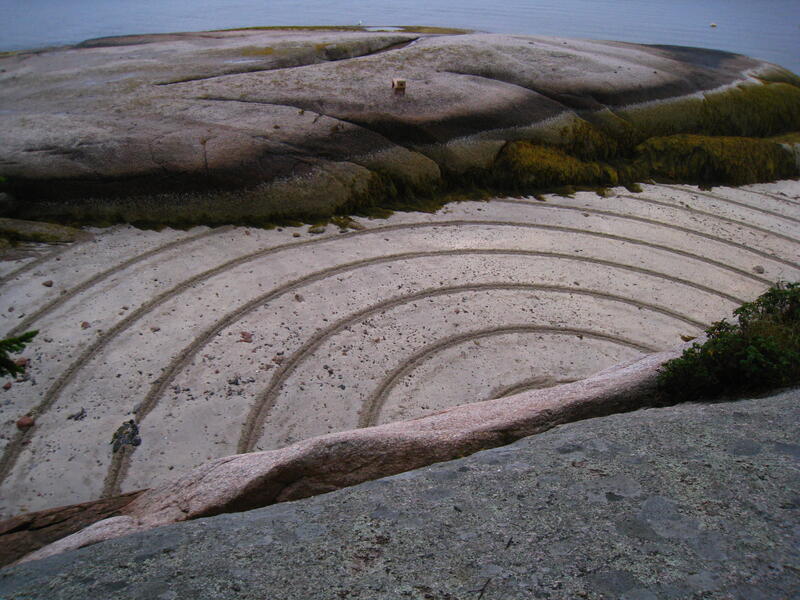 Beach circles, Deer Isles MA 2009Circles in sand on the beach in Deer Isles. MA
Beach circles, Deer Isles MA 2009Circles in sand on the beach in Deer Isles. MA -
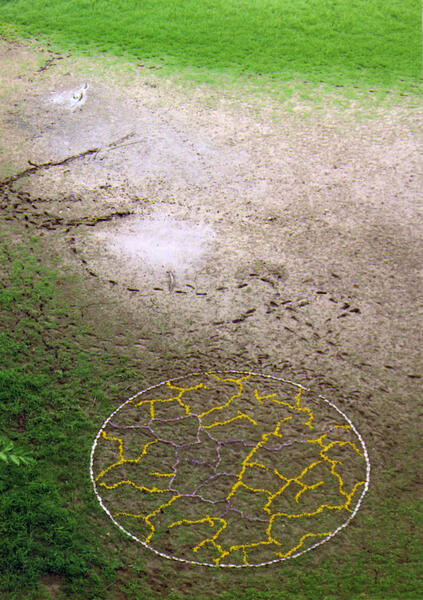 Gunpowder River project 2007Installation on the Gunpowder river, Phoenix MD. Sneezeweed flowers, freshwater mussels and butterfly weed used to mark the mud cracks on the Gunpowder river. The mussels marked out a 20ft diameter circle on the river bed while the level was low.
Gunpowder River project 2007Installation on the Gunpowder river, Phoenix MD. Sneezeweed flowers, freshwater mussels and butterfly weed used to mark the mud cracks on the Gunpowder river. The mussels marked out a 20ft diameter circle on the river bed while the level was low.
Box Constructions
Assemblages: Wood, stone, oil paint, sand, photographs, natural and manmade objects.
-
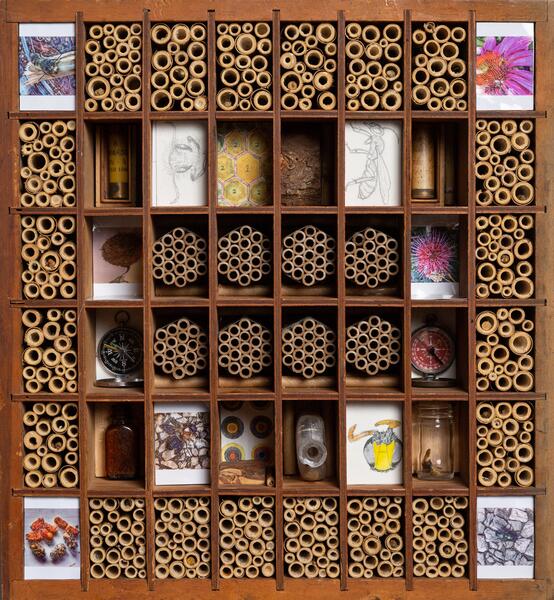 BEE HOUSE (2019)BEE HOUSE; Mixed media, 23" by 23"(2021). This box construction consists of bee tubes as used in solitary bee houses along with paintings, drawings and polaroids of work associated with solitary bees, specifically mason and leaf cutter bees. The box was shown at the Peale Center as part of the Baker Off the Web show and is now in a private collection.
BEE HOUSE (2019)BEE HOUSE; Mixed media, 23" by 23"(2021). This box construction consists of bee tubes as used in solitary bee houses along with paintings, drawings and polaroids of work associated with solitary bees, specifically mason and leaf cutter bees. The box was shown at the Peale Center as part of the Baker Off the Web show and is now in a private collection. -
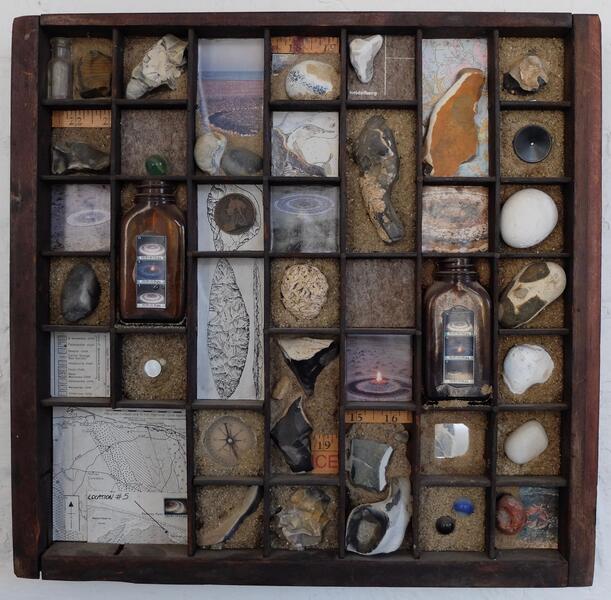 The age of flint 2005Box assemblage; collected flint, bottles, photographs, marbles, mirrors, geological drawings and text. 18" by 18"
The age of flint 2005Box assemblage; collected flint, bottles, photographs, marbles, mirrors, geological drawings and text. 18" by 18" -
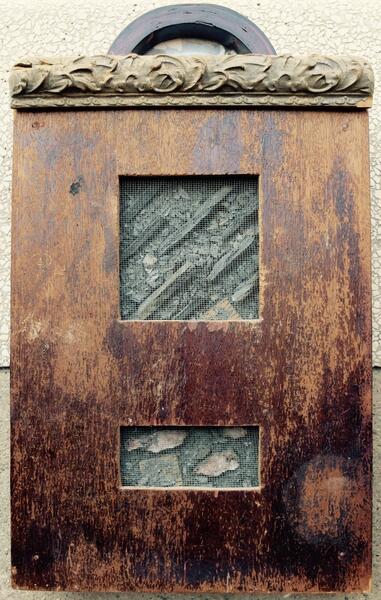 Death by Cleavage 1991Box assemblage; stone, ruler. 12" by 16"
Death by Cleavage 1991Box assemblage; stone, ruler. 12" by 16" -
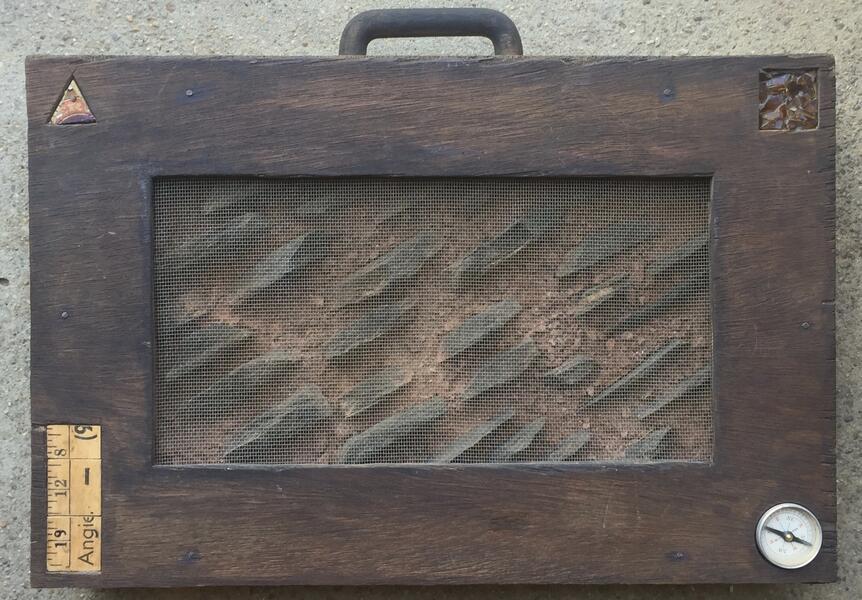 Death by Cleavage IV 1994Box assemblage; slate with red sandstone. 16" by 10"
Death by Cleavage IV 1994Box assemblage; slate with red sandstone. 16" by 10" -
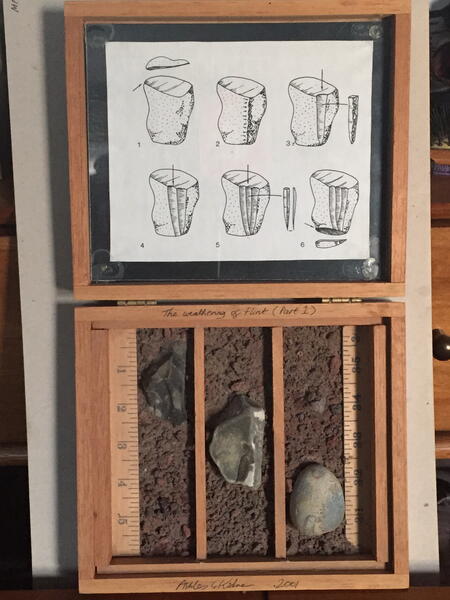 The weathering of flint (pt. 1) (2005)Box assemblage constructed with flint,stonedust, wooden ruler.
The weathering of flint (pt. 1) (2005)Box assemblage constructed with flint,stonedust, wooden ruler. -
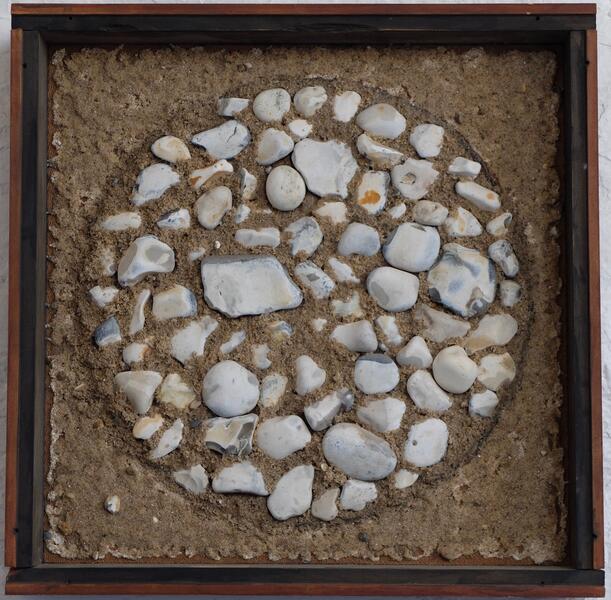 White flint circle 2005Box assemblage; flint with sand and glue. 14" by 14"
White flint circle 2005Box assemblage; flint with sand and glue. 14" by 14" -
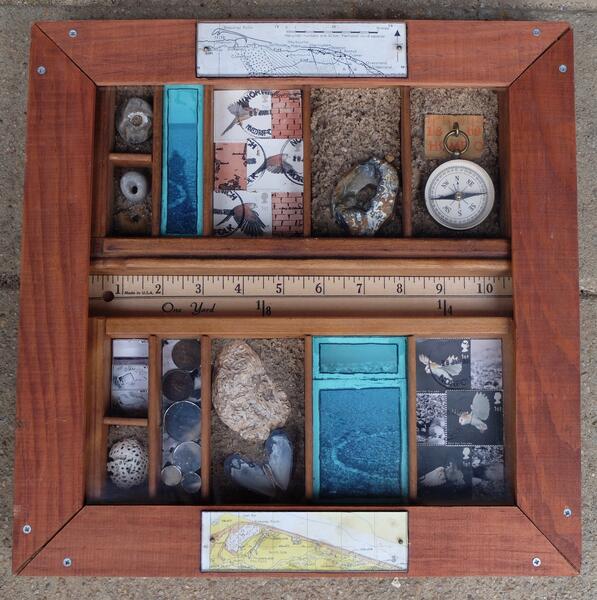 Blakeney Point Box # L249 LF (2007)Box assemblage; flint, maps, stamps, compass, photographs of installations, sand 10"by 10"
Blakeney Point Box # L249 LF (2007)Box assemblage; flint, maps, stamps, compass, photographs of installations, sand 10"by 10" -
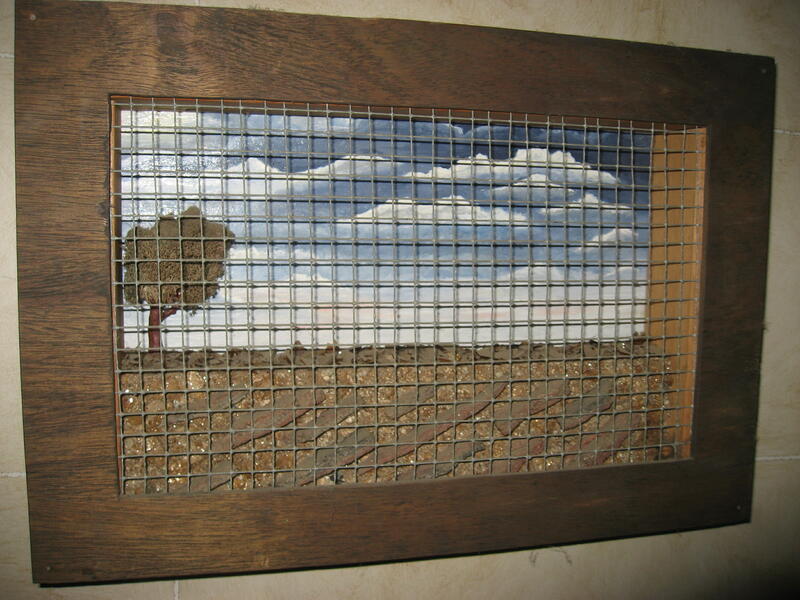 Death by cleavage III 1992Box assemblage; Stone, crushed mica, toy tree, oil painting on board. 16" by 10"
Death by cleavage III 1992Box assemblage; Stone, crushed mica, toy tree, oil painting on board. 16" by 10" -
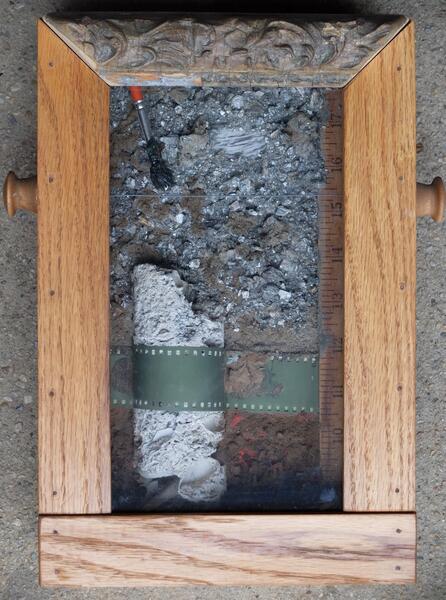 Black Gold 1992Box construction: red sandstone, mica, core sample (limestone), 35mm film, paintbrush, black and white photograph
Black Gold 1992Box construction: red sandstone, mica, core sample (limestone), 35mm film, paintbrush, black and white photograph -
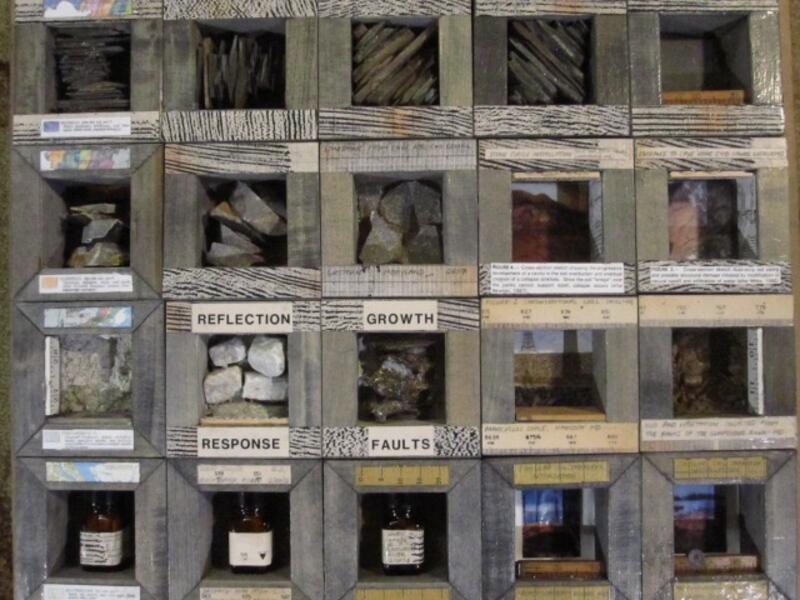 Box sketches 2014A series of 4" by 4" box sketches, containing stone, geology maps, photographs, water sample bottles. This series was inspired by the anti-fracking campaign in MD and talks about the relationship between man and water pollution. This Piece won first prize in the bridges in science exhibition (2014) put on by Towson Arts Collective.
Box sketches 2014A series of 4" by 4" box sketches, containing stone, geology maps, photographs, water sample bottles. This series was inspired by the anti-fracking campaign in MD and talks about the relationship between man and water pollution. This Piece won first prize in the bridges in science exhibition (2014) put on by Towson Arts Collective.
Watercolors
The watercolors presented in this project are all recent ( 2019-2023) with some inspired by my interest in mutation. My recent work, as a response to the Covid 19 pandemic, has produced a series of works inspired by nature but often featuring strange twists or mutations. Some of these drawings and paintings were started after I had a medical procedure to insert a small tube in my body where a large aneurysm had developed.
-
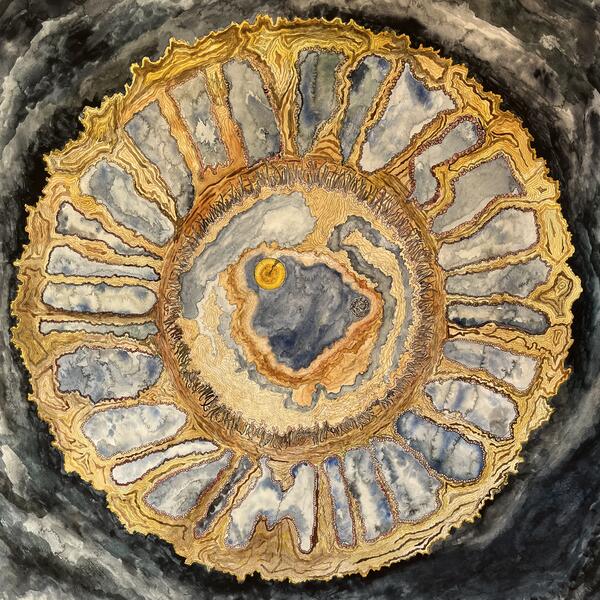 The expansion of the universe 2022THE EXPANSION OF THE UNIVERSE (2022); Pencil, Ink and watercolor on paper, 42"by 42" This work was inspired by the amazing photographs from the space telescope Hubble and most recently Webb.
The expansion of the universe 2022THE EXPANSION OF THE UNIVERSE (2022); Pencil, Ink and watercolor on paper, 42"by 42" This work was inspired by the amazing photographs from the space telescope Hubble and most recently Webb. -
Death of a Cactus
-
Angliacus anglicanna naturalis
Angliacus anglicanna naturalis, 2021 Iliacus anglicanna naturalis, 2021 Pencil, Ink and watercolor on paper (24" by 42")
-
 Oak seed Mutation, 2021Pencil, ink and watercolor on paper, 22" by 42".
Oak seed Mutation, 2021Pencil, ink and watercolor on paper, 22" by 42". -
Feather mutation (2022)Pencil, Ink and watercolor on paper (2021). 24" by 44"
-
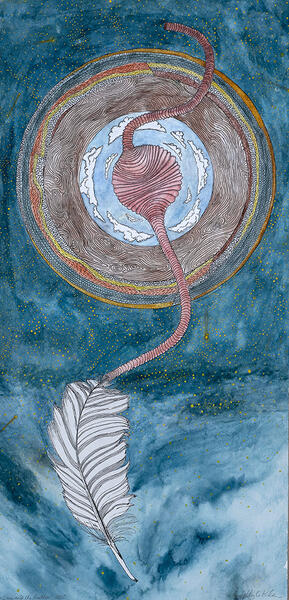 The Lung and Feather 2020Pencil, ink and watercolor. 36" by 18"
The Lung and Feather 2020Pencil, ink and watercolor. 36" by 18" -
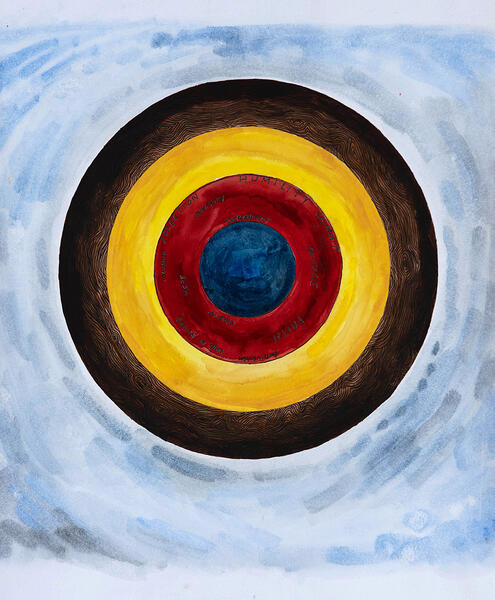 The colors of the soul (2019)This watercolor (18" by 18") is from a series I've been working on drawing influence from a book about the soul, which was acquired by the Dutch art collector George Loudon. The book was on display at an exhibition at the Whitechapel Gallery, London in 2019 but viewers only able to read 1 page. At the time I was awaiting an operation to remove a large aneurysm in my left iliac and became fascinated with the notes in the book describing different soul colors, there supposedly being only red, blue, yellow and brown.
The colors of the soul (2019)This watercolor (18" by 18") is from a series I've been working on drawing influence from a book about the soul, which was acquired by the Dutch art collector George Loudon. The book was on display at an exhibition at the Whitechapel Gallery, London in 2019 but viewers only able to read 1 page. At the time I was awaiting an operation to remove a large aneurysm in my left iliac and became fascinated with the notes in the book describing different soul colors, there supposedly being only red, blue, yellow and brown. -
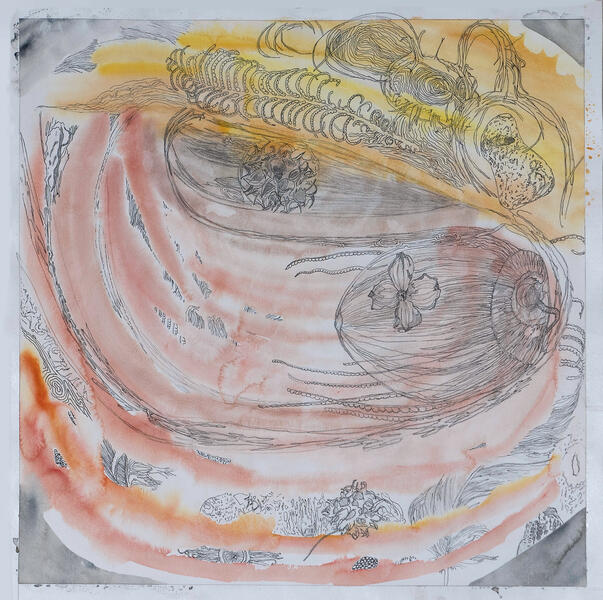 Acorn mutation (2021)Acorn Mutation (2021) Watercolor, pencil and ink on paper 24" by24"
Acorn mutation (2021)Acorn Mutation (2021) Watercolor, pencil and ink on paper 24" by24" -
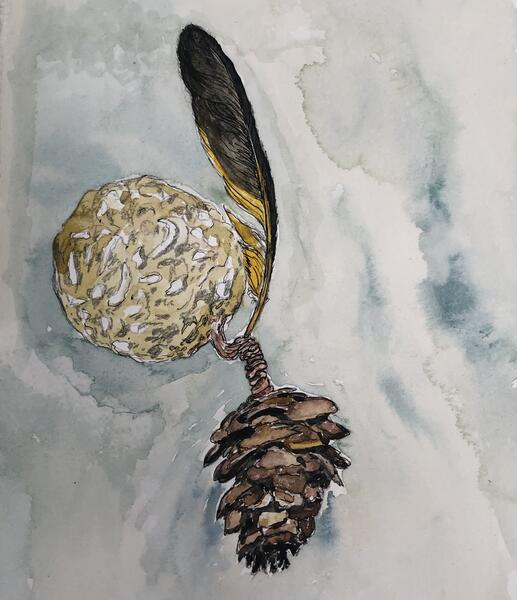 Praying feather
Praying featherWatercolor on paper, 10" by 8", 2022
-
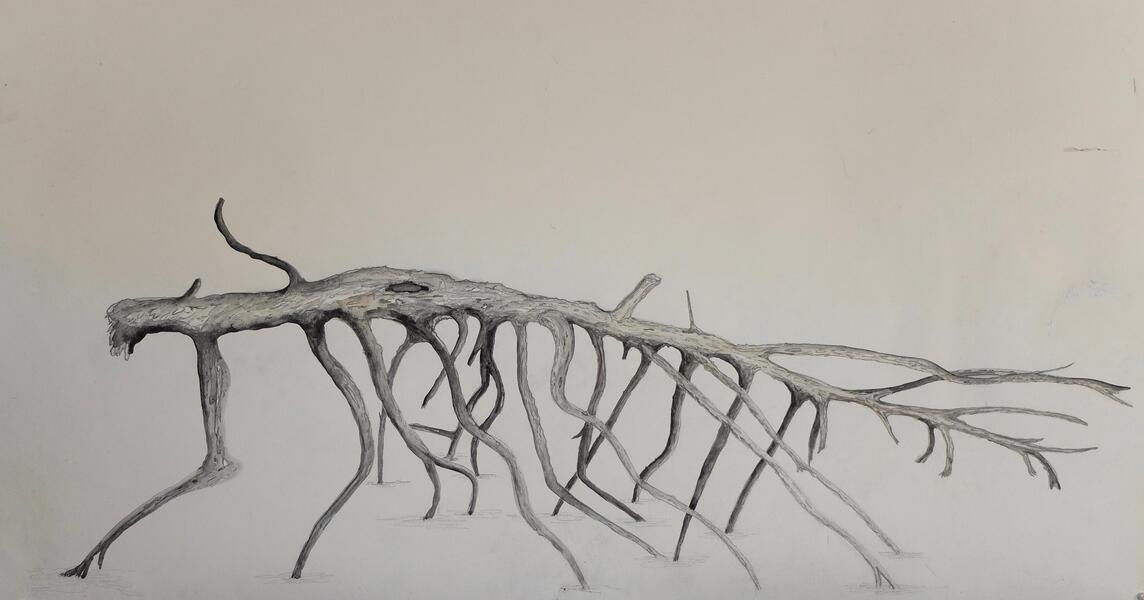 Hambleton Island Project
Hambleton Island ProjectPencil, watercolor on paper, 20" by 30"
Blakeney Point Flint Projects 2-4 & 6, 2005/09
The installations 2 through 4 were more like sketches for Blakeney Point flint Project #5. Project #6 was the last installation I did and involved returning the area to it's natural state, once the installation had been photographed.
-
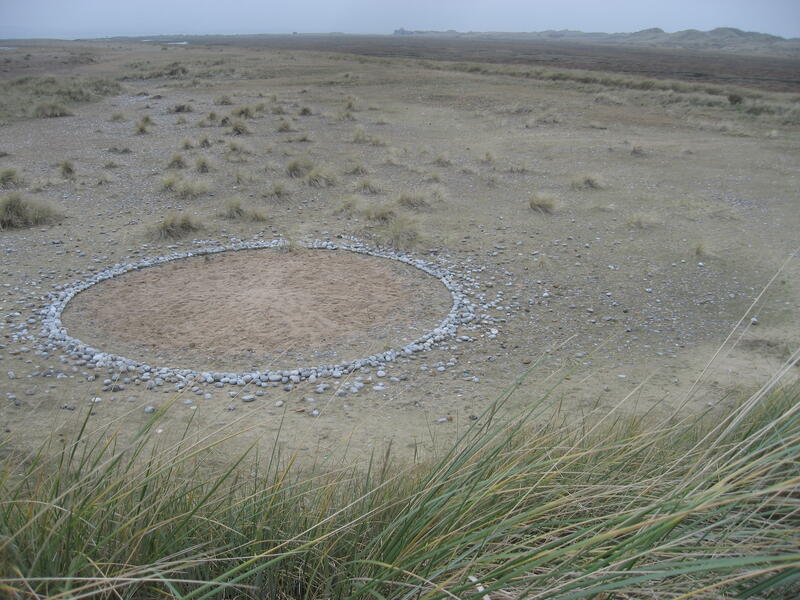 Blakeney Point flint project #6, 2009In this installation nearly all the flints were removed from within a 20ft diameter circle. Photo taken from dunes.
Blakeney Point flint project #6, 2009In this installation nearly all the flints were removed from within a 20ft diameter circle. Photo taken from dunes. -
 Tan colored flint with mortician's ruler.
Tan colored flint with mortician's ruler. -
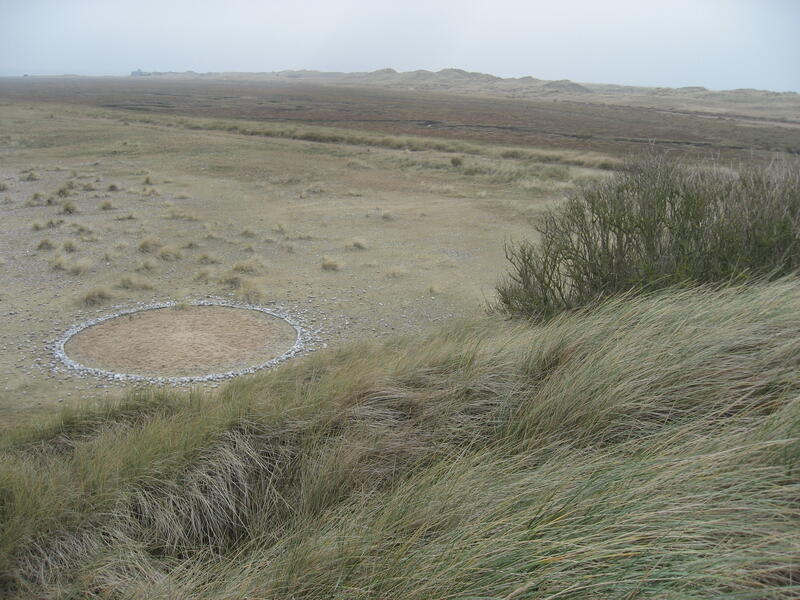 Blakeney Point flint project #6, 2009Circle diameter 20ft, flint within circle paced outside with density fading with distance from circle.
Blakeney Point flint project #6, 2009Circle diameter 20ft, flint within circle paced outside with density fading with distance from circle. -
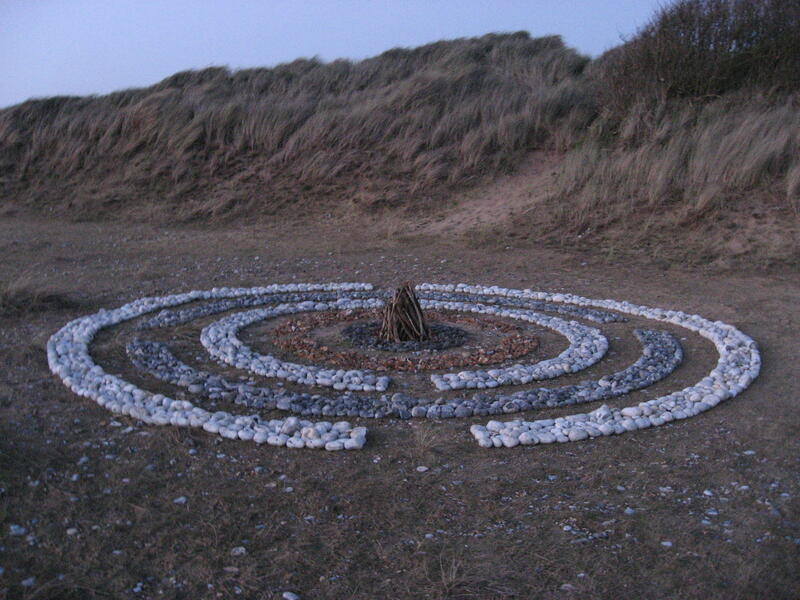 Blakeney Point flint project #4 2007Photo looking north towards the sand dunes
Blakeney Point flint project #4 2007Photo looking north towards the sand dunes -
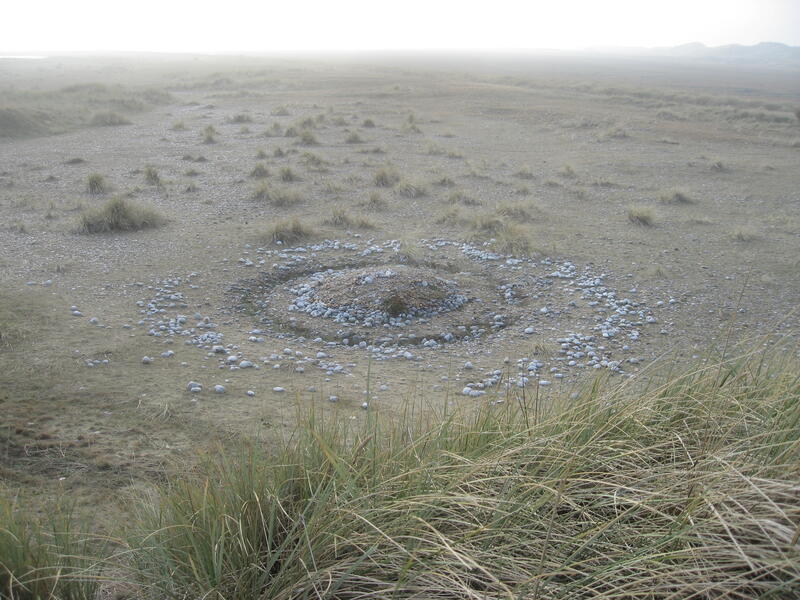 Blakeney Point flint project #5 2009Remnants of project #5 approx. 1 year after installation was completed. What struck me about this was that in the 6 odd years I had worked on Blakeney point the occurrence of really high or super tides had become more frequent.
Blakeney Point flint project #5 2009Remnants of project #5 approx. 1 year after installation was completed. What struck me about this was that in the 6 odd years I had worked on Blakeney point the occurrence of really high or super tides had become more frequent. -
 Blakeney Point flint project #4In this installation the gaps in the white flint represent north and south, with north being to the right. Photo taken from sand dunes looking towards Morston.
Blakeney Point flint project #4In this installation the gaps in the white flint represent north and south, with north being to the right. Photo taken from sand dunes looking towards Morston. -
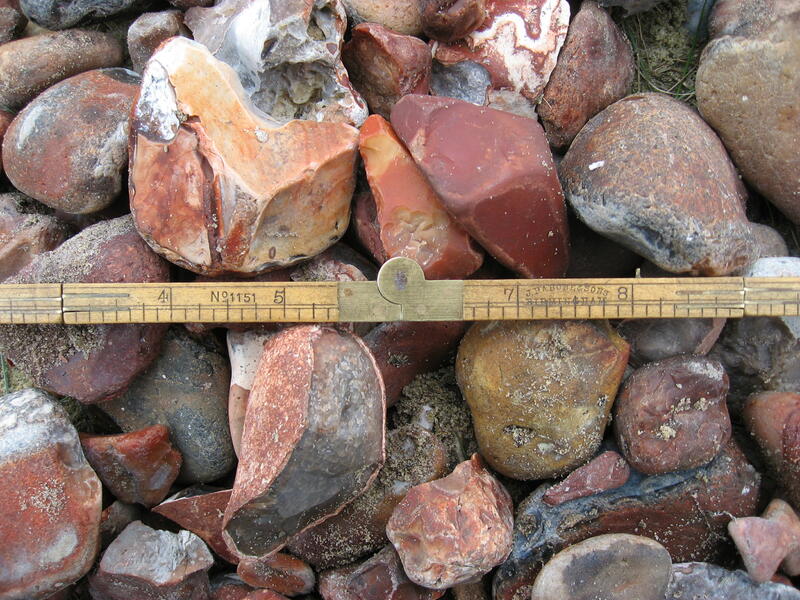 Red Flint with mortician's ruler
Red Flint with mortician's ruler -
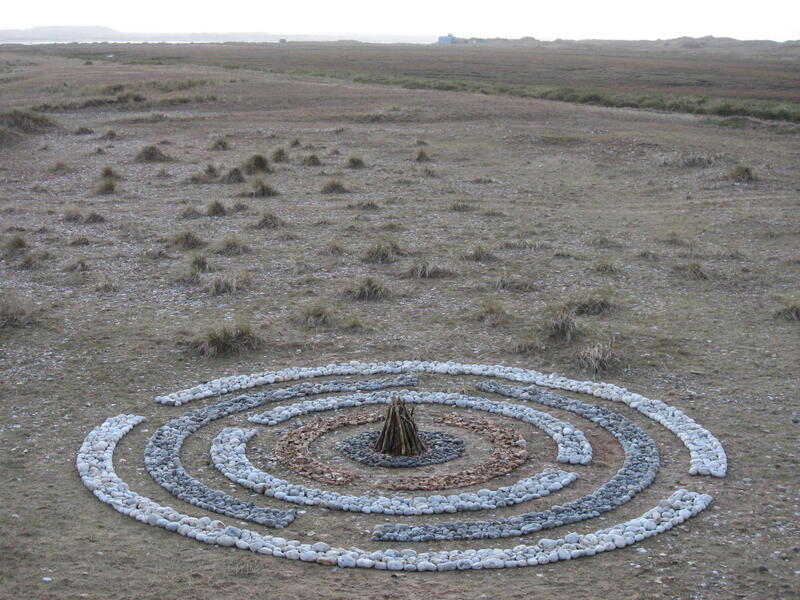 Blakeney Point flint project #4 2007Flint circles of different colors arranged on Blakeney Point, Norfolk, England, The gaps in the circles represent north and south.
Blakeney Point flint project #4 2007Flint circles of different colors arranged on Blakeney Point, Norfolk, England, The gaps in the circles represent north and south. -
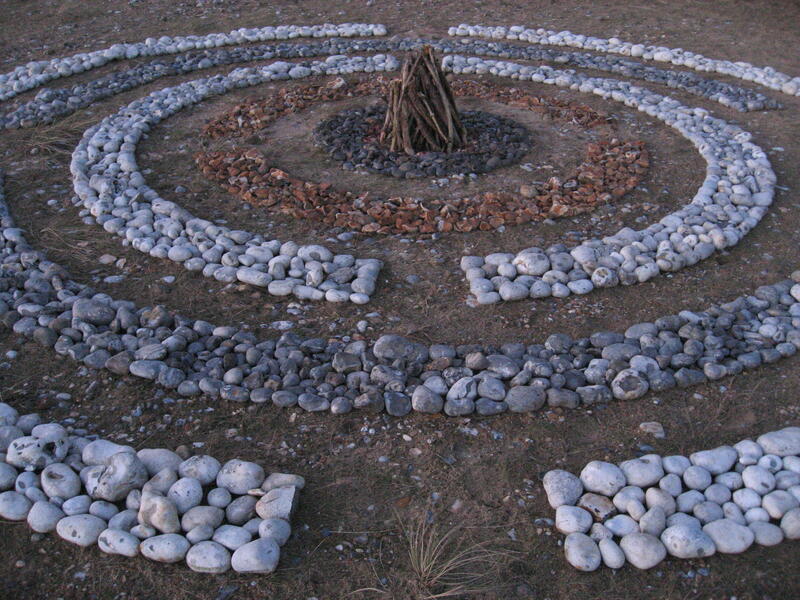 Blakeney Point flint project #4 2007Photo looking along north/south axis of installation.
Blakeney Point flint project #4 2007Photo looking along north/south axis of installation. -
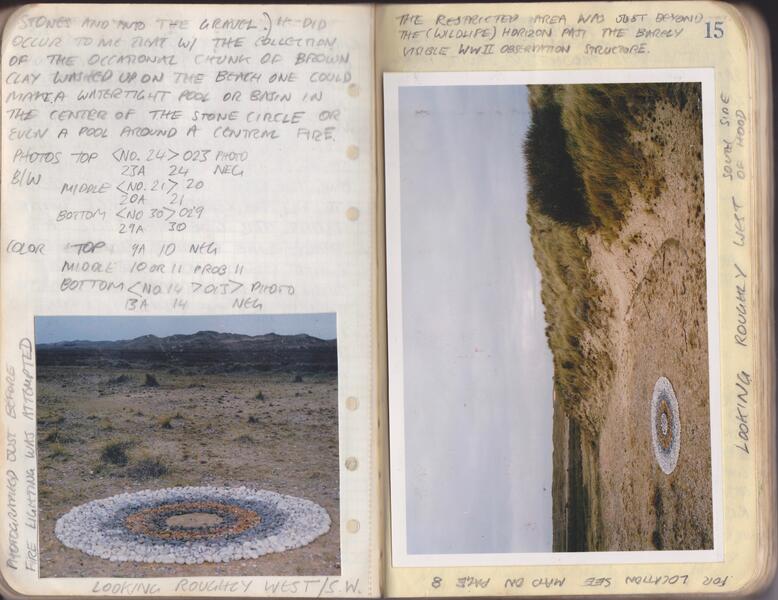 Blakeney Point Flint project #2, 2005Notes from sketch book on Blakeney Point flint Project #2
Blakeney Point Flint project #2, 2005Notes from sketch book on Blakeney Point flint Project #2
Nature Art in the Park 2014-Present
The first installation, Well of Passion, was constructed in a small depression using cut vines, mainly the invasive wisteria chinensis. 1 vineball was placed in the "well" while the other was suspended (again using cut vines) from a tree above the well.
The second installation, Fiddlehead Rising, was constructed using stone which had fallen from an old wall running close to the installation, and again cut wisteria chinensis vines. The stones were placed in a spiral form representing the unfurling of fiddleheads in ferns, with a vine atttached to the tip of the stone, stretching to a nearby tree. A vineball was suspended from the vine.
The 3rd installation was Pollinator Hexagon III
-
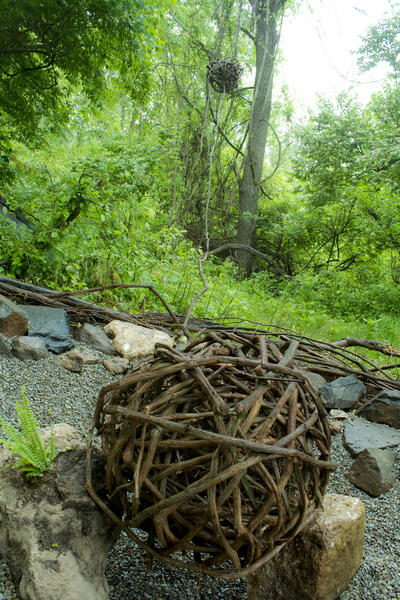 Well of Passion, Nature Art in the Park, Leakin Park, Baltimore. 2014Vine Balls constructed from wisteria vine, suspended from surrounding trees, stone, gravel.
Well of Passion, Nature Art in the Park, Leakin Park, Baltimore. 2014Vine Balls constructed from wisteria vine, suspended from surrounding trees, stone, gravel. -
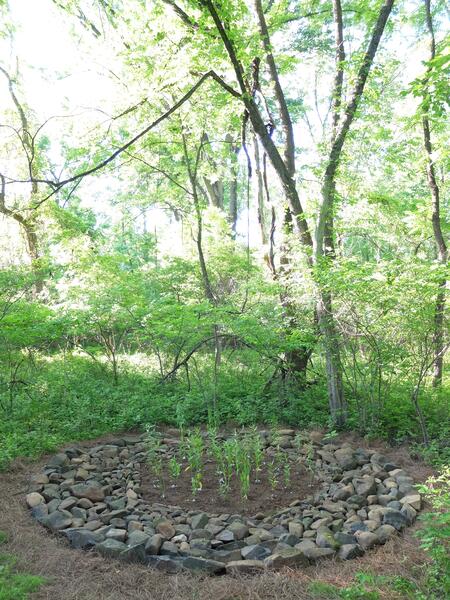 Pollinator Hexagon III18ft diameter circle constructed with stone (baltimore gneiss) found nearby, plantings in the hexagonal area were asclepias incarnata (milkweed) #3 in the pollinator hexagon series.
Pollinator Hexagon III18ft diameter circle constructed with stone (baltimore gneiss) found nearby, plantings in the hexagonal area were asclepias incarnata (milkweed) #3 in the pollinator hexagon series. -
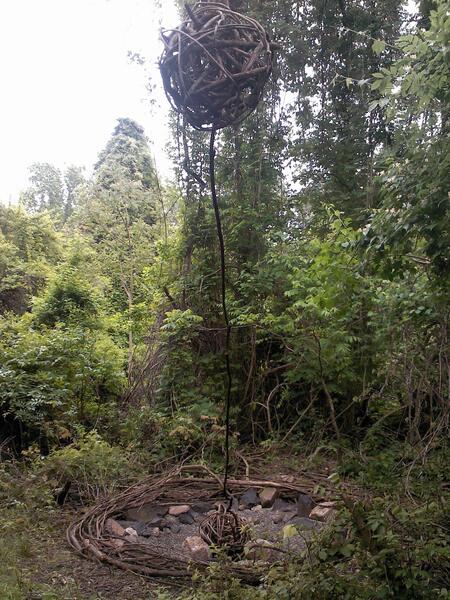 Well of passion 2014Well of Passion: 2 vineballs (constructed from wisteria chinensis), 1 in the well of passion 1 suspended from the trees.
Well of passion 2014Well of Passion: 2 vineballs (constructed from wisteria chinensis), 1 in the well of passion 1 suspended from the trees. -
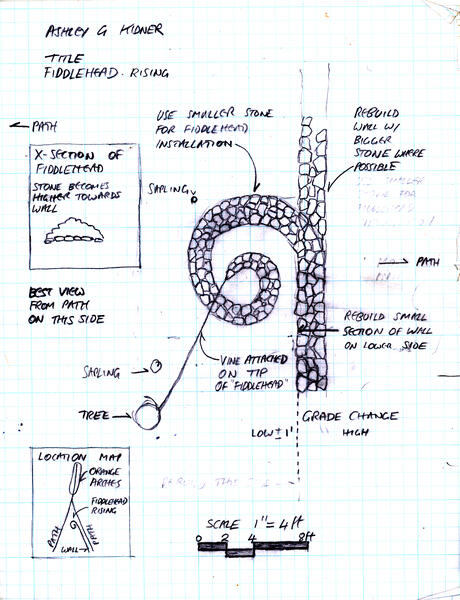 Fiddlehead Rising 2015Sketch of installation for fiddlehead Rising
Fiddlehead Rising 2015Sketch of installation for fiddlehead Rising -
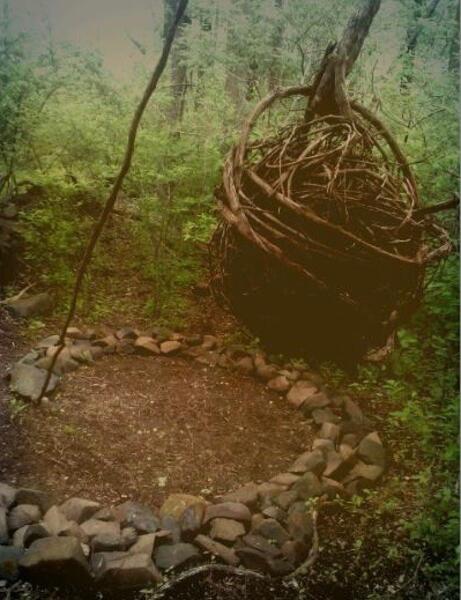 Fiddlehead Rising 2015Fiddlehead stonework with hanging vine ball
Fiddlehead Rising 2015Fiddlehead stonework with hanging vine ball -
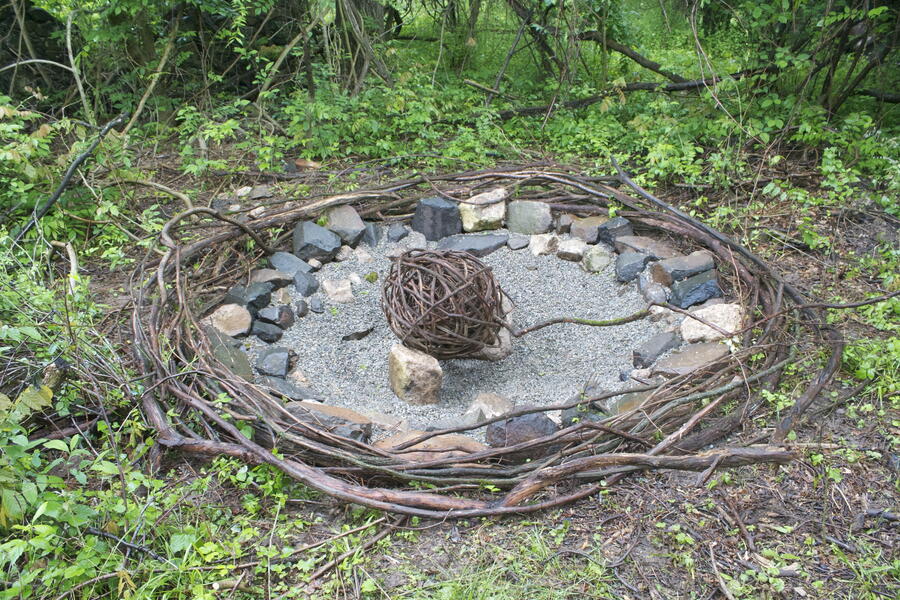 Well of Passion, Nature Art in the Park, 2014, Leakin Park, BaltimoreVine ball constructed from wisteria vine, circle vines also wisteria, stone, gravel, existing stone
Well of Passion, Nature Art in the Park, 2014, Leakin Park, BaltimoreVine ball constructed from wisteria vine, circle vines also wisteria, stone, gravel, existing stone -
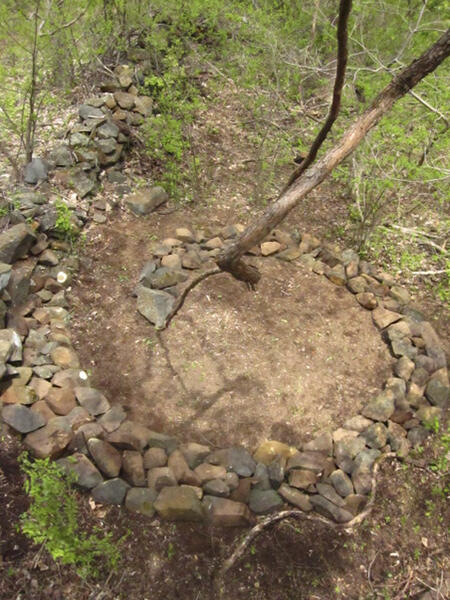 Fiddlehead Rising 2015Photo after vine attached to tip of fiddlehead.
Fiddlehead Rising 2015Photo after vine attached to tip of fiddlehead. -
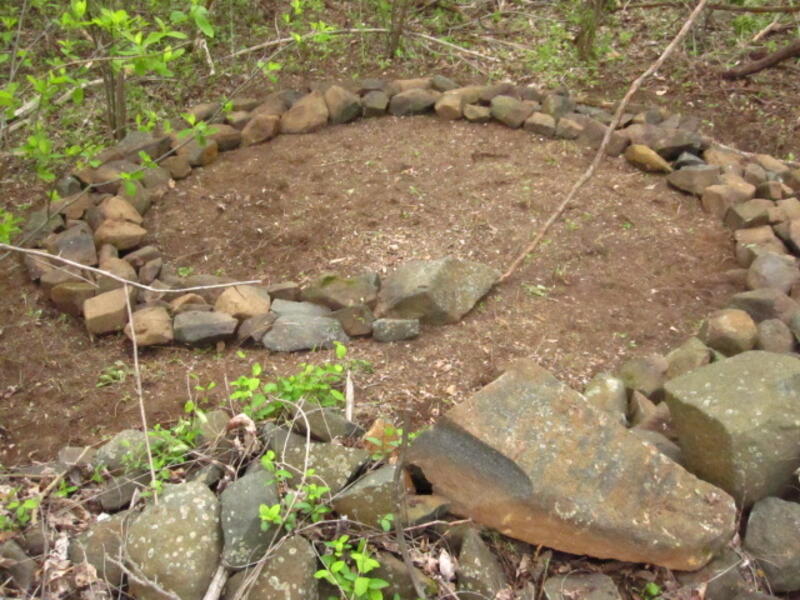 Fiddlehead Rising 2015Stone from the nearby collapsed wall was used to create a spiral representing the newly emerging fiddleheads of ferns. A vine from a tree, next to the installation, was attached to the tip of the fiddlehead.
Fiddlehead Rising 2015Stone from the nearby collapsed wall was used to create a spiral representing the newly emerging fiddleheads of ferns. A vine from a tree, next to the installation, was attached to the tip of the fiddlehead. -
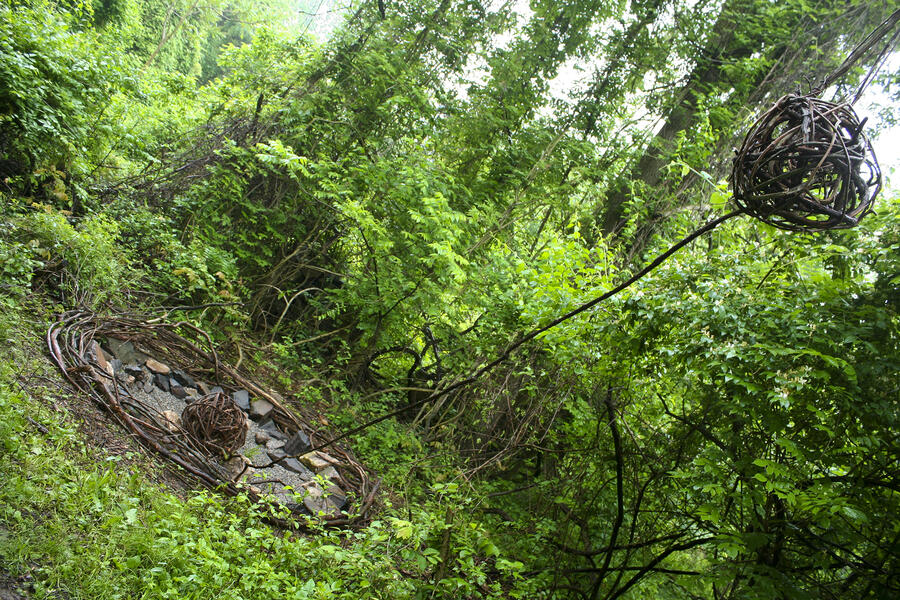 nature in the park.jpgWell of Passion, Nature Art in the Park, 2014, Leakin Park, Baltimore.
nature in the park.jpgWell of Passion, Nature Art in the Park, 2014, Leakin Park, Baltimore. -
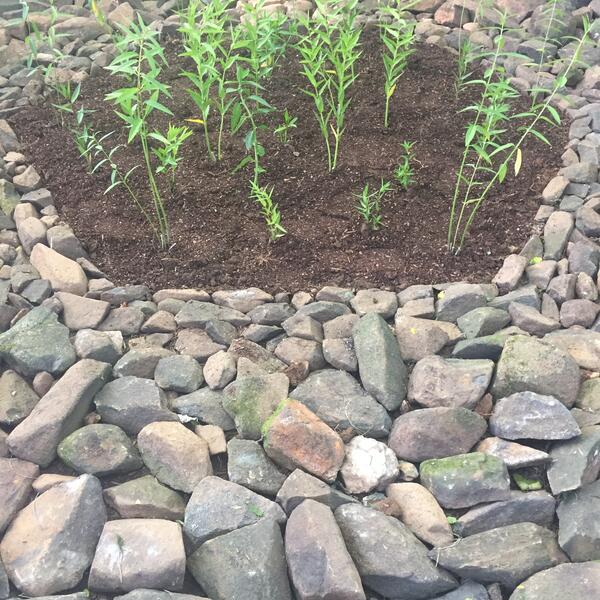 Pollinator Hexagon III 2017Detail of stonework and planting area with asclepius incarnata (milkweed)
Pollinator Hexagon III 2017Detail of stonework and planting area with asclepius incarnata (milkweed)
Earth Works installed in Reykjavik, Iceland and the UK
Blakeney Point Flint Project #5 was the culmination of 4 previous installations (or sketches) in exactly the same location on Blakeney Point in Norfolk, UK. The installation was a homage to the Neolithic stone circles found throughout the British Iles.
2009 Basaltic Hexagon project; Basalt stones were collected and placed in a hexagonal pattern, each hexagon approx. 3ft in width. The pattern reflects the nature of basalt when emerging from the earth, it often forms large hexagonal layers. The installation was started at low tide, I then worked until high tide started to lap on to the completed hexagons.
2014 The worship of Basalt I and II; Location directly at the end of runway for Reykjavik airport. A large basalt boulder (approx. 3ft long) lying secluded from the surrounding rocks was selected for the installation. Small basalt stones with kelp attached were selected then dragged across the sand and placed with the stones facing the boulder. The action of dragging the stones across the sand (which had a light dusting of snow on it) left interesting lines on the beach. The installation was performed 2 times on consecutive days (high tide washing away the stones overnight); in part 1 a hexagon was formed around the boulder, in part 2 the shape was an outline of the boulder.
-
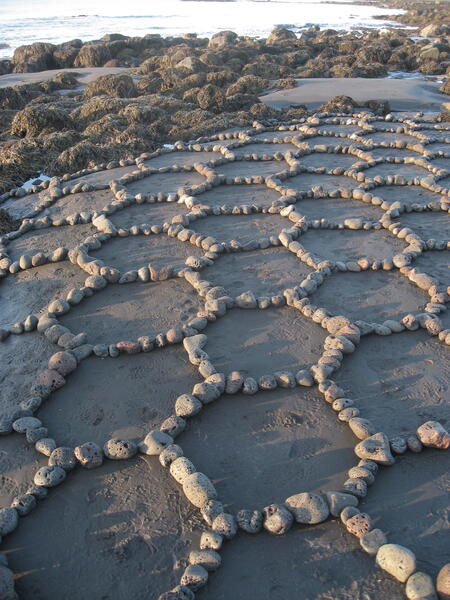 Basaltic Hexagon project 2009Basalt stones arranged in hexagonal form at low tide, late afternoon.
Basaltic Hexagon project 2009Basalt stones arranged in hexagonal form at low tide, late afternoon. -
 Blakeney Point Flint Project #5 2007Photograph taken from the dunes just above the installation.Cairn, henge and stonework completed, fire lit and burning in the late afternoon.
Blakeney Point Flint Project #5 2007Photograph taken from the dunes just above the installation.Cairn, henge and stonework completed, fire lit and burning in the late afternoon. -
Blakeney point flint project #5 2007
This photograph shows a close up of the installation after the central fire had burned.
-
 Blakeney Point Flint project cabinet installed for Artscape 2017 Fieldwork Exhibtion.
Blakeney Point Flint project cabinet installed for Artscape 2017 Fieldwork Exhibtion.This cabinet installation was exhibited as part of the Fieldwork exhibition for Artscape 2017. It contained photographs, sketches, samples of flint, box constructions and reference books all related to the Blakeney Point flint projects installed in Norfolk, England between 2003-2008.
-
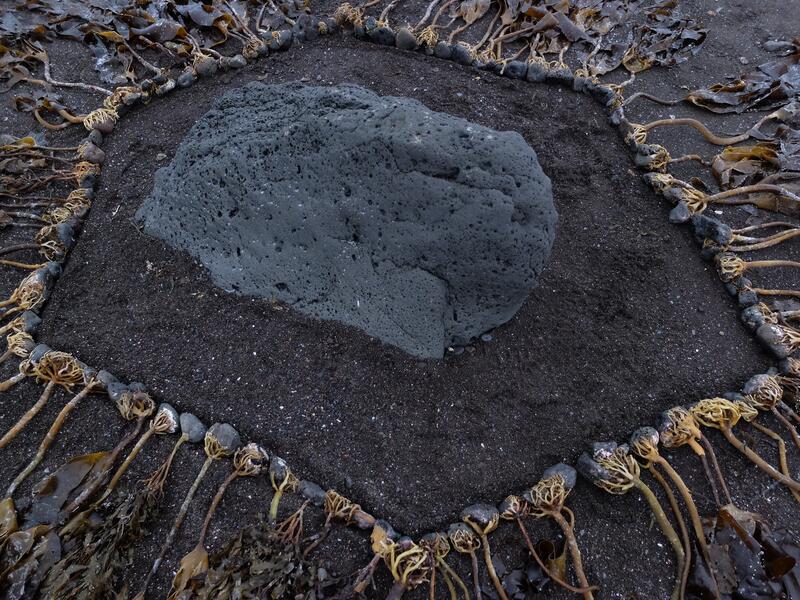 The worship of Basalt (pt. 1)THE WORSHIP OF BASALT (Pt. 1) 2014 Installed on the Beach near Reykjavik airport, Reykjavik, Iceland. Basalt boulder surrounded by small basalt stones with kelp attached. The hexagonal shape reflects the form basalt takes when deposited in large layers on the sea floor.
The worship of Basalt (pt. 1)THE WORSHIP OF BASALT (Pt. 1) 2014 Installed on the Beach near Reykjavik airport, Reykjavik, Iceland. Basalt boulder surrounded by small basalt stones with kelp attached. The hexagonal shape reflects the form basalt takes when deposited in large layers on the sea floor. -
 The worship of Basalt part 2The small basalt pebbles encircle and pay homage to the boulder
The worship of Basalt part 2The small basalt pebbles encircle and pay homage to the boulder -
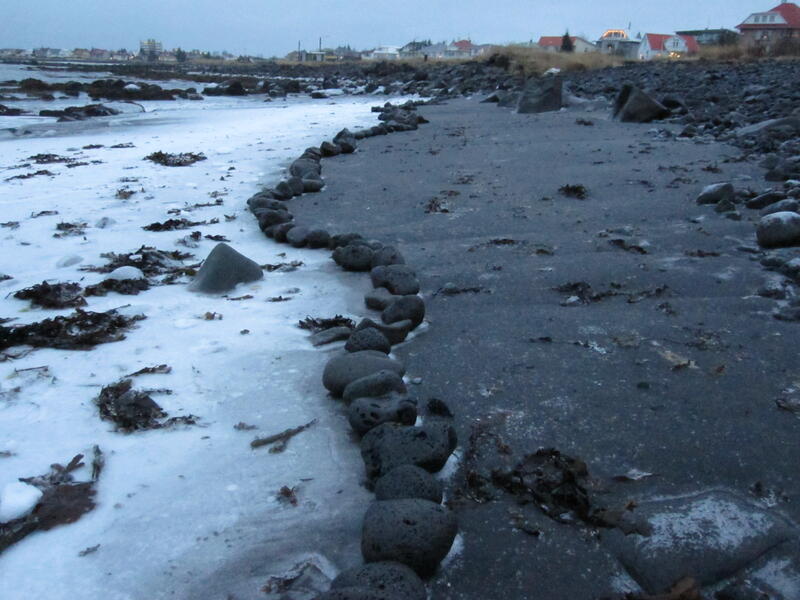 Basalt High Tide Marker 2010In this installation I walked along the beach at low tide and tried to guess at the location where high tide would come up to on the beach. Basalt stones were collected and placed to mark the positions. On return the next day I found my guesses to be correct, the atlantic ocean side of the stones were frozen while the landward side remained unfrozen. The effect was as if the stones had stopped the high tide at this point.
Basalt High Tide Marker 2010In this installation I walked along the beach at low tide and tried to guess at the location where high tide would come up to on the beach. Basalt stones were collected and placed to mark the positions. On return the next day I found my guesses to be correct, the atlantic ocean side of the stones were frozen while the landward side remained unfrozen. The effect was as if the stones had stopped the high tide at this point. -
 The worship of BasaltSmall basalt stones with kelp attached. The roots from the kelp were able to penetrate the porous basalt stones.
The worship of BasaltSmall basalt stones with kelp attached. The roots from the kelp were able to penetrate the porous basalt stones. -
 Stone Cairn (2022)This stone cairn (5ft tall max diameter 22") was built with a mix of stone, constructed dry laid (no mortar). It will be eventually converted into a bee friendly water feature.
Stone Cairn (2022)This stone cairn (5ft tall max diameter 22") was built with a mix of stone, constructed dry laid (no mortar). It will be eventually converted into a bee friendly water feature. -
 Blakeney Point flint project #4 2007Photo looking along north/south axis of installation.
Blakeney Point flint project #4 2007Photo looking along north/south axis of installation.















